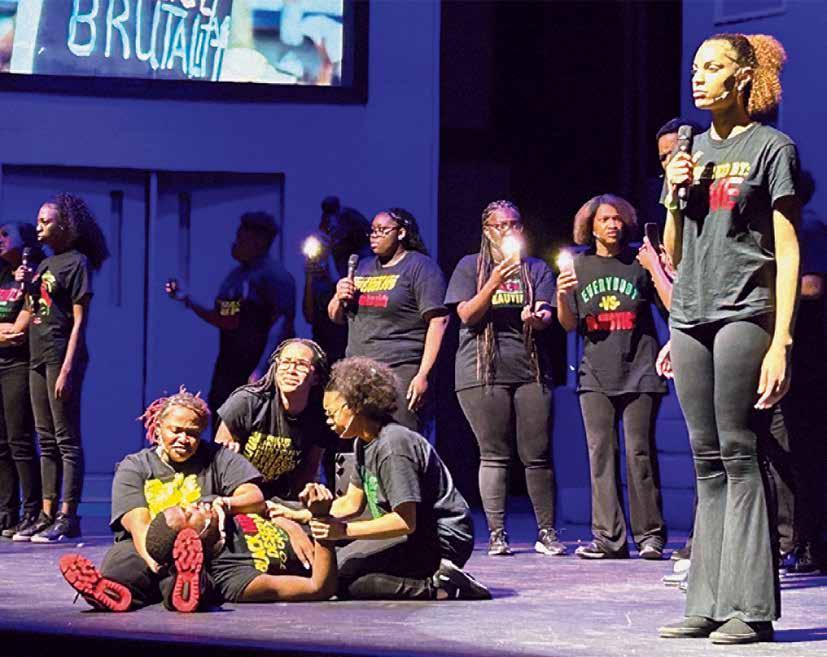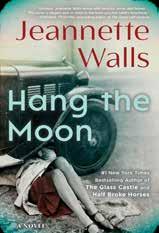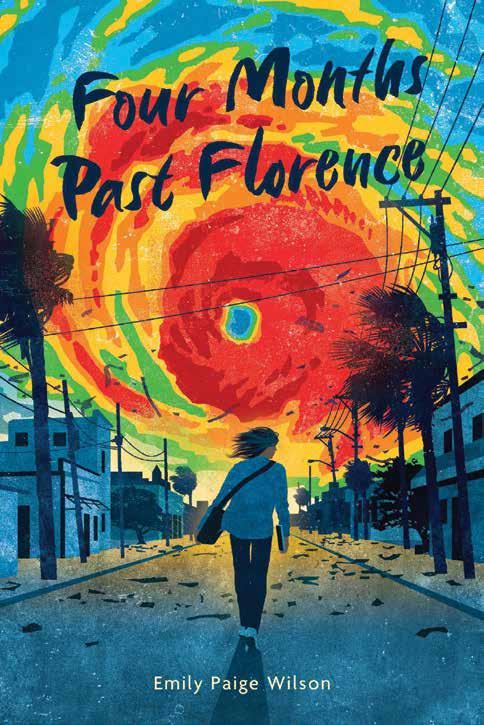Glitter, glamour, and stepping out onto Raleigh burlesque's pink carpet as conservatives aggressively roll back rights.









































































 By Sarah Edwards, p. 13
By Sarah Edwards, p. 13



Raleigh | Durham | July 12, 2023
Raleigh W Durham W Chapel Hill
VOL. 40 NO. 24
CONTENTS
NEWS
4 Tenants living on Durham's Open Air Camp Road organized to avoid eviction and secured their forever homes. BY
LENA GELLER
8 How will Durham leaders address the mental health impacts on young people living with gun violence?
BY THOMASI MCDONALD
10 A new fund aims to preserve affordable housing in Wake County, but local, mission-based landlords are still struggling to find ways to keep rents low.
BY JASMINE GALLUP
ARTS & CULTURE
13 Glamour, glitter, and gloves: The tight-knit Raleigh burlesque scene celebrates 16 years. But dancing in the South isn't always easy.
 BY SARAH EDWARDS
BY SARAH EDWARDS
16 The poet Ross White finds beauty in looking at things a little sideways.
BY SHELBI POLK
18 A review of Blair LM Kelley's powerful new book about the Black working class. BY
THOMASI MCDONALD
20 What draws us to write about hurricanes? BY
WILEY CASH
THE REGULARS
3 Backtalk | 15 Minutes 21 Culture calendar
COVER Performer Mona Loverly at Raleigh burlesque's 16th anniversary show.
PUBLISHER
John Hurld
EDITORIAL
Editor in Chief
Jane Porter
Culture Editor
Sarah Edwards
Staff Writers
Jasmine Gallup
Lena Geller
Thomasi McDonald
Contributors
Spencer Griffith, Carr Harkrader, Brian Howe, Kyesha Jennings, Jordan Lawrence, Glenn McDonald, Nick McGregor, Gabi Mendick, Shelbi Polk, Dan Ruccia, Harris Wheless, Byron Woods
Copy Editor
Iza Wojciechowska
Interns
Mariana Fabian, Hannah Kaufman, Iris Miller
CREATIVE
Creative Director
Nicole Pajor Moore
Graphic Designer
Izzel Flores
Staff Photographer
Brett Villena
ADVERTISING
Publisher
John Hurld
Director of Revenue
Mathias Marchington
CIRCULATION
Berry Media Group
MEMBERSHIP/ SUBSCRIPTIONS
John Hurld
INDY Week | indyweek.com P.O. Box 1772 • Durham, N.C. 27702 919-666-7229
EMAIL ADDRESSES first initial[no space]last name@indyweek.com
ADVERTISING SALES advertising@indyweek.com 919-695-4848

Contents © 2023 ZM INDY, LLC
All rights reserved. Material may not be reproduced without permission.
2 July 12, 2023 INDYweek.com
Selwyn Birchwood performs at The Blue Note Grill on Friday, July 21. (See calendar, page 21.)
PHOTO COURTESY OF THE BLUE NOTE GRILL
W
E M A D E T H I S
PHOTO BY ANDY MILLS
Back in February, we published a story about the namesakes of several buildings on NC State’s campus (and other buildings on UNC system campuses), many of which have roots in white supremacy. While we mentioned NC State’s Talley Student Union in the story, we didn’t elaborate on the man for whom it is named—
Banks C. Talley II, the university’s longtime vice chancellor for student affairs and a champion for diversity and opportunities for all students to achieve a balanced education. This month, we heard from Banks C. Talley’s son, BANKS C. TALLEY III, who lives in Raleigh and has thoughts about his father’s legacy. We’re publishing his letter here.
Dear INDY Editors,
This is just a polite suggestion but the next time you write an article about renaming NCSU (or other UNC system campus buildings), it might be relevant to reach out to the children of the people you mention in your article. Some of us are very much alive and still living in the Triangle and we care very much about our parents’ legacy.
My Dad gave his entire career (with the exception of 2 leaves of absence, (1. To serve as Governor Hunt’s 1st Chief of Staff in 1977 and 2. To serve as the Executive Vice President of the National Trust for Historic Preservation) to NC State University. He loved the university, he cared deeply about diversity and equal rights for women. He made sure to hire diverse leaders and he mentored (quite literally) thousands of undergraduate and graduate students during his 33 initial years of service. In the latter stages of his career, he mentored even more students and staff through his work for Arts NC State (22 years worth).
I take no issue with mentioning his name in the article BUT please (the next time) take a few column inches to expand upon the contributions of the person you are referencing. When the Talley Student Union was named after my father, it was the greatest honor of his life and career. He was no racist but rather a very deserving leader and administrator. Thank you and keep doing that “INDY” thing!
Sincerely,
Banks C. Talley III
NCSU ‘92, ‘96 and ‘02
15 MINUTES
Emma Livingston and Rese Milkereit Founders of the Durham Community Art Project
 BY MARIANA FABIAN backtalk@indyweek.com
BY MARIANA FABIAN backtalk@indyweek.com
What did you envision for the mural and what do you hope people gain from this?
Emma: During the planning stages, we were collecting community survey responses, and the questions ranged from what would you want to see in a mural at Duke Park to what are some things you’re experiencing right now during the pandemic, and what colors do you like—broad questions.
One question was, “Where are you coming from?” since we would collect these surveys at Duke Park. We were receiving survey responses from people all over the Triangle during the pandemic. People were traveling to Duke Park during the pandemic to bring kids to play and for socially distanced activities, and I was surprised to see that. I thought it was mostly Duke Park neighbors; it just goes to show how many people actually use the park from all over Durham and the broader Triangle.
The mural artist, Renzo Ortega, actually titled the mural Abrazo Eterno—an eternal embrace, and he described it as symbolizing that Durham always welcomes you. Our hope for the project is that this mural represents everyone and all who come to utilize the park. The symbolism of a journey is also an important piece that we saw from the beginning stages, from the Community Survey input all the way until the very last finishing touch.
How were you
able to bring this to life?
Rese: We gathered a committee of people who brought different skills and backgrounds to the table and represented the Durham community in different ways.
Andrew Preiss is a member of the Duke Park community and a local artist. Cornelio Campos is a well-known and successful community muralist and painter in the Triangle. We had some people who are connected with the City of Durham,
Annette Smith and Susan Taylor, who also are close to Duke Park, people who could give us the know-how from the city’s perspective and from the community perspective.
We had José Santibañez, my high school teacher’s husband. He’s a sweet guy and he runs Bull City Futsal. They have used the Duke Park tennis courts for their practices. It was awesome to get him on board as somebody who uses that space. He’s just well-loved in the community. We got people who are connected with the city, with art in Durham, the youth, and the space all together.
The committee and Cornelio helped form the connection we have with Zarazua Painting, a local Latino-owned painting company in Durham. They donated all the paint for the project. We couldn’t have done it without them.
Our beloved committee member Michelle Gonzalez-Green passed away before the completion of the mural. Michelle was integral in the beginning stages of the project and coined our name, “Duke Park Community Mural Project.” The inspiration she instilled in us lives through Abrazo Eterno.
How can community members contribute to getting this project on the ground running?
Emma: We’re having a community celebration and an official unveiling on July 15 from 4–8 p.m. Artists are performing, we will have a community potluck and live musicians, and then a drag show. We would love to support our artists and we have a GoFundMe. Other than that, coming to the event and celebrating the mural is how locals can get involved. W
INDYweek.com July 12, 2023 3
PHOTO BY BRETT VILLENA
Durham
This interview has been edited and condensed for clarity. Visit our website to read the full version of this article.
WANT TO SEE YOUR NAME IN BOLD? indyweek.com backtalk@indyweek.com @INDYWeekNC @indyweek B A C K T A L K
Home Free
How tenants living on Durham’s Open Air Camp Road organized to avoid eviction and secured their forever homes.
BY LENA GELLER lgeller@indyweek.com
“The biggest thing for me,” Sheba Everett says, “is that my six-year-old will be able to say, ‘This is my childhood home. This is the home I grew up in.’”
On cue, six-year-old Hannah, the youngest of Everett’s five daughters, pokes her head out from behind a staircase banister and grins.
We’re sitting in the living room of a brick five-bedroom on Open Air Camp Road in Durham, situated several hundred feet from the banks of the Eno River, with a front yard so large that a trampoline, a fire pit, and a brawny, rope swing-strung oak tree barely put a dent in its real estate.
It’s a home that Everett has spent much of the past year fighting to keep. In spring of this year, the effort proved successful.
Everett is one of 27 tenants who faced displacement when the Eno River Association (ERA), a land trust and conservation nonprofit, issued eviction notices last year as part of a long-held plan to sell an 18-acre land parcel—and the seven homes that occupy it—to the state parks department. The state intended to use the homes as free housing for park rangers.
As the INDY previously reported, the tenants, some of whom have inhabited the homes for a decade or more, were shocked when notices to vacate were posted on their doors in September.
The ERA had not disclosed that the properties, affordably leased since the 1990s, were being held for a future transfer. In fact, property management company V.S. Rich Property Services had repeatedly assured tenants that they could stay on Open Air Camp
Road for as long as they liked and one day initiate rent-to-own agreements. With that in mind, many had endured poor living conditions and invested their own dollars into repairs that property management refused to make. (Jessica Sheffield, executive director of the ERA, previously told the INDY that property management staff had assured her “they made the repairs tenants requested” and that she doesn’t know why tenants
So they organized, and after months of incremental progress the tenants forged a legal agreement with the ERA. The organization published an insert for the Festival for the Eno in the INDY last month presenting a rescindment of the eviction notices and a plan to transfer most of the houses to a housing nonprofit that will ensure “they’re forever preserved as affordable homes in Durham.”
The ERA has also waived tenants’ rental payments since October and worked on needed repairs, according to the insert.
In an email to the INDY , Sheffield wrote that the organization cannot currently discuss further details of the agreement, including the identity of the housing nonprofit, due to a confidentiality clause in the land transaction.
In North Carolina, where tenant protections are scarce, winning an eviction case is rare. And winning a case in this way—where tenants can remain in their homes and start on a path to land trust ownership, and where permanently affordable housing is created in a lush neighborhood with shade and slow street traffic— is likely unprecedented.
So how did they pull this off?
were never notified of the planned sale to the state.)
The eviction notices gave some households 10 months to vacate. Others were afforded less than two. Given current rent prices in Durham, displacement for most tenants would mean leaving the area or state or, at worst, encountering homelessness.
When Everett received an eviction notice—her household was one of three given less than two months to vacate—she immediately asked friends and coworkers to call the ERA. Branches Community School, where Everett works as a preschool teacher, launched a GoFundMe on her behalf. In a letter paired

4 July 12, 2023 INDYweek.com N E W S Durham
Tenant Sheba Everett, second from right, pictured with four of her five daughters at their home on Open Air Camp Road. PHOTO BY BRETT VILLENA
“The biggest thing for me is that my six-year-old will be able to say ‘This is my childhood home. This is the home I grew up in.’”
with the fundraiser, Everett bared her soul. She was a single mother with three jobs, she wrote. The same day she received the eviction notice, her eldest daughter’s car was totaled during a hit-and-run. She had recently exhausted her savings to pay for her late brother’s funeral expenses and support the children he left behind. She was reluctant to ask for help, she wrote, but she needed it.
“I had no organizing experience,” says Everett, who has lived on Open Air Camp Road with her daughters since early 2020. “I didn’t know what to do. So I was just like, ‘I’m gonna tell my community.’”
A few days later, Everett came home to find a letter taped to her front door. It was from her neighbors, Leslie (formerly Leslie Dreyer) and Jadelynn St Dre, a couple with more than a decade of organizing experience who had recently moved to Durham with their child following displacement from the Bay Area.
The St Dres weren’t ERA tenants, they told Everett, but could help strategize around fighting the evictions. Everett was game. They began knocking on doors.
“We started by talking to people about their connection to the homes,” Leslie says. “We asked, ‘Do you want to stay here?’ which is different from, ‘Do you believe you can stay here?’”
If the latter question is posed, the conversation typically comes to a screeching halt, Leslie explains. But when people are encouraged to discuss the experiences they’ve had in a home, they internalize their right to remain there. Like most long-term tenants who pay off entire mortgages on homes via rent and get no equi-
ty, several ERA tenants realized that they had invested more money into their homes than their landlords. They wanted to push back.
“Once a few houses were willing to fight, it built solidarity,” Leslie says, “and the houses who might have been reticent were down.”
Graham Jones was one of the reticent.
Jones has lived in ERA-owned properties for his entire adult life. He’s occupied his current rental for nearly two decades, and before that, he spent several years in a different house on Open Air Camp Road that was torn down when it fell into disrepair.

Like other ERA tenants, Jones and his wife, who preferred not to be named, sensed that something was awry
in June 2022. This was several months before receiving a notice to vacate, when state park rangers and ERA board members did a walk-through of their home, an inspection that seemed to forebode an upcoming sale.
“I mentioned multiple times that we were expecting a new child, and that I really needed to know if we were safe,” Jones says. “But they acted like we had nothing to worry about. We were moving around the [furniture in the] rooms, and they said, ‘Keep moving everything.’”
But his suspicions were confirmed in September when a neighboring ERA tenant divulged that an eviction notice was en route. The message was terrifying: Jones’s wife was eight months pregnant, and the couple’s other child, a teenage daughter, has a medical condition requiring regular treatment from specialists at Duke Hospital. Displacement from Open Air Camp Road would have meant displacement from the Triangle—and the state, Jones says—and losing proximity to his daughter’s healthcare.
Despite all this, when Jadelynn knocked on Jones’s door a few weeks later, Jones was hesitant.
“We felt like if we stuck our necks out there, they were just gonna kick us out before the [eviction] date,” Jones says. “That was a huge fear.”
He also had concerns around what it would mean to challenge a beloved local organization with a robust supporter base, which seemed more daunting than taking on a single, faceless landlord. But Jadelynn’s enthusiasm, and other tenants’ involvement, ultimately swayed him.
“The fact that we were able to come together as a group—that made me think we maybe had the power to
INDYweek.com July 12, 2023 5
“We felt like if we stuck our necks out there, they were just gonna kick us out before the [eviction] date. That was a huge fear.”
ERTA members at the ERA’s annual meeting in October PHOTO COURTESY OF ERTA
TH 7/27 @CAT’S CRADLE THE DRUMS
W/ COLD HART
7/14 FR: THE WEIGHT BAND FEAT. MEMBERS OF THE BAND & LEVON HELM BAND

7/20 TH: LESS THAN JAKE W/ VOODOO GLOW SKULLS, DEVON KAY

7/21 FR: HANK, PATTIE & THE CURRENT W/ ASHES AND ARROWS

7/27 TH: THE DRUMS W/ COLD HART

8/1 TU: JULIA JACKLIN W/ KARA JACKSON
FR 7/14
8/3 TH: NIKKI LANE W/ THE PINK STONES

8/7 MO: TESSA VIOLET W/ FRANCES FOREVER
8/10 TH: ALESANA W/ LIMBS, VAMPIRES EVERYWHERE, ACROSS THE WHITE WATER TOWER
8/15 TU: THE BASEBALL PROJECT FT PETER BUCK, SCOTT MCCAUGHEY, MIKE MILLS, LINDA PITTMAN AND STEVE WYNN W / BRETT HARRIS

8/17 TH: THE BETHS W/DISQ
8/19 SA: SLOW TEETH & FRIENDS PERFORM PINK FLOYD’S DARK SIDE OF THE MOON
8/23 WE: AJJ W/ OPEN MIKE EAGLE, SAD PARK, FOOT OX
8/25 FR: BEN NICHOLS BIKERIDERS
TOUR W/LULU & THE BLACK SHEEP, HOST OLIVER PECK
8/26 SA: BE LOUD ’23: R.E.M. BY THE MAXELL 90, ECHO AND THE BUNNYMEN BY PREEESH!
9/2 SA: TAYLOR SWIFT LASER DANCE PARTY
9/8 FR: COLONY HOUSE
9/9 SA: THE MILK CARTON KIDS W/CHARLIE HICKEY
9/12 TU: GLAIVE ( $25 / $28 )
9/13 WE: JEFF ROSENSTOCK W/ GLADIE, SIDNEY GISH
9/14 TH: DEERHOOF W/ FLYNT FLOSSY AND TURQUOISE JEEP
9/17 SU: IGORRR W/ MELT BANANA, OTTO VON SCHIRACH (RESCHEDULED)
9/20 WE: JOY OLADOKUN W/ BECCA MANCARI
9/21 TH: MIPSO
9/22 FR: OF MONTREAL

9/23 SA: SPAFFORD
9/24 SU: BORIS AND MELVINS W/ MR PHYLZZZ
9/26 TU: OSEES W/ NOLAN POTTER’S NIGHTMARE
9/28 TH: STOP LIGHT OBSERVATIONS
9/30 SA: THE NATIONAL PARKS W/ ZACH SEABAUGH
10/8 SU WILDERADO W/ CEGO
10/10 TU: ELECTRIC SIX W/ THE SURFRAJETTES
10/13 FR: CIAN DUCROT
10/14 SA: GEORGE CLANTON W/ FROST CHILDREN, DEATH’S DYNAMIC SHROUD

10/15 SU: NEIL FRANCES
10/16 MO: VACATIONS AND LAST DINOSAURS
10/18 WE: GUS DAPPERTON W/ ABBY SAGE
10/20 FR: YEULE ($24 / $27)
10/26 TH: JUKEBOX THE GHOST PRESENTS HALLOWQUEEN!
10/31 TU: BELL WITCH W/ SPIRIT POSSESSION
11/2 TH: TORTOISE
11/3 FR: ROBBIE FULKS / SLAID CLEAVES
11/5 SU: THE DEAR HUNTER W/ DELTA SLEEP, ALL GET OUT
11/6 MO: THE JAPANESE HOUSE
11/9 TU: NATION OF LANGUAGE W/ MISS GRIT
11/11 SA: THE OCEAN BLUE
11/14 TU: SLAUGHTER BEACH, DOG W/ BONNY DOON ( $25/$28)
2/7/24 WE: HOTELIER + FOXING
CATS CRADLE BACK ROOM
7/14 FR: TUPELO CRUSH BO-STEVENS, CHARLES LATHAM & FRIENDS
7/15 SA: THE SHOALDIGGERS, MYSTERY RANCH, COUNTRY CRUEL
7/16 SU: HARBOUR W/ SYLMAR
7/19 WE: ANDMOREAGAIN PRESENTS: MOTHERFOLK W/ BROTHER BIRD, YOUNG MISTER
7/21 FR: A CARRRBORO BACK TO THE FUTURE PROM: FT MIX TAPE GRAB BAG
7/22 SA: OLIVE DARES THE DARKNESS W/ ANIMALWEAPON, WAKING APRIL
7/23 SU: HONEY MAGPIE, ANNIE STOKES, COLIN CUTLER AND SAM FOSTER
7/25 TU: MOUNTAIN GRASS UNIT
7/27 TH: SCHOOL OF ROCK ALLSTARS
7/28 FR: JESSE FOX W/JOSEPH TERRELL, TROPICAL MAN GO
7/29 SA: OLD SOLAR W/ EARTHER, OLD BRIER
7/30 SU: WISH QUEEN / MEGABITCH / HOLLYO
8/2 WE: LATE NIGHT DRIVE HOME W/ BENCHES
8/4 FR: PIPE RECORD RELEASE SHOW W/ SHARK QUEST
8/5 SA: ALEXA ROSE W/ ALYCIA LANG, EARLEINE
8/6 SU: WCOM BENEFIT
8/11 FR: ROD ABERNETHY / REBEKAH TODD
8/16 WE: MOLLY PARDEN W/ ANDREW GOLDRING
8/17 TH: HOTEL FICTION / TRASH PANDA
8/18 FR: ARCY DRIVE
8/19 SA: RUEN BROTHERS
8/20 SU: JILL ANDREWS
8/22 TU: ANDMOREAGAIN PRESENTS: THE ANCHOR W/ NOTIONS
8/25 FR: BRISCOE
8/26 SA: LITTLE IMAGE W/ HASTINGS, LEVI EVANS
30 WE: THE THING W/ THE MODERN AGE
9/3 SU: JAGUAR SUN W/ EDWIN RAPHAEL
9/8 FR: HANNAH JADAGU W/MILOE
9/10 SU: ANDMOREAGAIN PRESENTS: DJUNAH W/ LUNG
9/12 TU: CHRIS FARREN W/ DINERS
9/14 TH: RICHY MITCH & THE COAL MINERS
9/16 SA: TOM THE MAIL MAN
9/20 WE: ISLANDS W/BRNDA
9/22 FR: WHITEHALL
9/24 SU: ROYEL OTIS W /FRIKO
9/26 TU: JORDANA AND DEV LEMONS
9/27 WE: KATELYN TARVER W/ JACK GRAY
9/28 TH: KATE BOLLINGER
10/5 TH: FRENSHIP
10/8 SU: HOLY FAWN W/CARACARA
10/12 TH: A GIANT DOG
10/14 SA: DAN RODRIGUEZ
10/17 TU: YAM HAUS + SAWYER
10/20 FR: CLEM SNIDE
10/24 TU: MARGO CILKER W/HUMBIRD

10/27 FR: GATLIN
11/1 WE: VINCE HERMAN BAND ($22/$25)
11/4 SA: PETEY ($25/$28)
HAW RIVER BALLROOM (SAX)
7/14 FR: SON VOLT ( 28 YEARS OF SON VOLT)
7/27 TH: ALTIN GÜN W/ ROGÊ
9/15-17 FR-SU: HISS GOLDEN MESSENGER (3 SHOWS!)
10/3 TU: SHOVELS AND ROPE BARE BONES TOUR
10/12 TH: SUZANNE VEGA – AN INTIMATE EVENING OF SONGS AND STORIES ( $45/$48)
11/3 FR: RAYLAND BAXTER
12/9 SA: ANGEL OLSEN W/ SLUICE
RITZ (RALEIGH)
8/6 SU: SHAKEY GRAVES W/ ABRAHAM ALEXANDER
10/10 TU: THE MIDNIGHT MOTORCO ( DURHAM)

8/13 SU: THE CLIENTELE
9/17 SU: JOSHUA RADIN
9/25 MO: YOUTH LAGOON W/ ULRIKA’S BEDROOM
10/6 FR: FIELD MEDIC
10/18 MO: GENERATIONALS
10/24 TU: PALEHOUND W/ EMPATH
10/28 SA: HOJEAN
10/29 SU: SLOW PULP W/ BABEHOVEN
11/8 SA: JOHN R MILLER
DPAC (DURHAM)
10/3 TU: GREGORY ALAN ISAKOV W/DAMIEN JURADO
NCMA ( RALEIGH)
8/18 FR: STEEP CANYON RANGERS W/ AMYTHYST KIAH
LINCOLN THEATRE ( RALEIGH)
10/31 TU: QUICKSAND LOCAL 506 ( CHAPEL HILL)
7/26 TU: SIR WOMAN
9/30 SA: BANDALOS CHINOS
10/18 WE: BE YOUR OWN PET
THE KRAKEN (HIWAY 54 W)
7/22 SA: GEORGE SHINGLETON
6 July 12, 2023 INDYweek.com
CATSCRADLE.COM • 919.967.9053 • 300 E. MAIN STREET • CARRBORO
@CAT’S CRADLE THE WEIGHT BAND FEAT. MEMBERS OF THE BAND & LEVON HELM BAND TH 7/27 @HAW RIVER BALLROOM ALTIN GÜN TH 8/3 @CAT’S CRADLE NIKKI LANE MO 8/7 @CAT’S CRADLE TESSA VIOLET TU 8/15 @CAT’S CRADLE THE BASEBALL PROJECT FT. PETER BUCK, SCOTT MCCAUGHEY, MIKE MILLS, LINDA PITTMAN AND STEVE WYNN TH 7/20 @CAT’S CRADLE LESS THAN JAKE W/ VOODOO GLOW SKULLS, DEVON KAY CAT'S CRADLE 11/9 TH: JACK KAYS – GOES SOUTH 11/14 TU: BILLY RAFFOUL 12/6 WE: THE MOSS 1/28/24 SU: OCIE ELLIOTT FR 7/21 @CAT’S CRADLE HANK, PATTIE & THE CURRENT W/ ASHES AND ARROWS SOLD OUT SOLD OUT SOLD OUT
get things changed,” Jones says.
By early October, all seven households were on board and the Eno River Tenants Association (ERTA) held its first official meeting.
“In the beginning, we all just talked to make sure everybody wanted the same results,” Everett says. “It was important for us to all be on the same page.”
Tenants’ shared goals were recast as a list of demands for the ERA: rescind the notices to vacate, restore damaged houses to healthy habitability standards, and transfer the homes to tenant ownership using a shared equity land trust model, among others.
Since the ERA had refused to rescind the eviction notices when confronted privately, tenants decided to go public with their demands and published an online petition.
The petition garnered more than 700 signatures and worked to aggregate evidence of widespread support while functioning as a direct line of communication between the ERTA and its advocates.
That line of communication was vital. On one end, tenants received ongoing morale boosts from petition supporters who paired their signatures with encouraging words. On the other end, supporters, all of whom provided contact information via the petition, received emails with status updates and calls to action.
Toward the end of October, the ERTA sent a message asking supporters to join them in staging a surprise demonstration at the ERA’s annual meeting.
The ERA likely got wind of the plan; tenants all received last-minute invitations to speak at the meeting taped to their doors. (Per the ERA, the timing of the meeting “aligned well with our interest in getting together with the tenant families to hear directly from them and further our dialogue.”) But tenants’ showing up and delivering personal testimonies ultimately proved disruptive anyway. Many ERA members and several newer board members stated they were hearing about the land transfer’s human impact—and conditions tenants were experiencing—for the first time.
“We’d been out of sight, out of mind,” Everett says. “So we got in sight.”
Five days after the meeting, and two days after the INDY reported on the pending evictions, the ERA announced it would push back eviction dates by several months; waive all rents, effective immediately; and investigate allegations of tenant mistreatment by V.S. Rich Property Services. Several ERA board members also started advocating to the rest of the organization on tenants’ behalf, Leslie says.
The next month, after the News & Observer published
a story and accompanying video detailing Everett’s fight against displacement as a single Black mother, the ERA almost immediately announced that it had “tabled the sale of the homes” to the state parks department. In the same announcement, the ERA apologized to tenants and stated that it had “made mistakes throughout this process.”
Getting into sight was making an impact.
Everett, who prefaced her September fundraiser memo with the line “feeling too proud to ask and too embarrassed to let people in, I almost opted out of writing this letter today”—but who ultimately emerged as chief spokesperson of the ERTA—says speaking openly was a crucial skill that she honed over the months-long organizing effort.
“If you’re ever faced with something like this, it’ll be hard to be vulnerable with your community,” she says. “But for me, being vulnerable with my community has been one of the biggest and most beautiful experiences that I’ve ever had.”
Even with publicity and community support, though, fatigue set in by January.
The ERA still hadn’t rescinded the eviction notices, leaving tenants in a precarious position. If they spent their free time organizing, they risked running out of time to find housing if the effort failed. If even a few of them exited the ERTA to devote time to house hunting, the group could lose its collective power, and if, like Everett, they tried to both organize and look for new homes while working a full-time job and raising a family, their health would deteriorate.
“I was getting sick,” says Everett. “Physically sick, mentally sick—I couldn’t handle it. The limbo was making me feel like I’m teeter-tottering on the edge of a bridge, not knowing if I’m gonna be down there with the sharks.”
Jones was also on the brink—“the uncertainty of everything made it feel like it would almost be better just to give up and figure out another situation,” he says—but found solace in the growing list of petition signatures, which made him “feel like we weren’t wrong for pushing for what we felt was right.”
Everett ultimately turned to God for guidance, she says, and received a message: This house is yours; stop looking. She complied.
In February, things started to align.
The ERA expressed interest in learning more about the shared equity land trust housing models that the ERTA had outlined in its petition, reaching out for a meeting with an organization that tenants had recommended. After that, the first ERA-ERTA meeting was scheduled for late February, with the two groups agreeing that a
mediator and a legal scholar should attend to assist with the process.
For the mediator role, the ERTA recommended Manju Rajendran, a conflict transformation facilitator. Rajendran’s “liberatory lens” was crucial, Leslie says, noting that a legal-oriented mediator likely would not have acknowledged the harms done to tenants.
“This whole fight was about ethics, not legality, so we had to have facilitators who understood that major part of the struggle,” Leslie says.
Professor Andrew Foster and a team of students with Duke Law Community Enterprise Clinic would provide collaborative legal support to help both parties iron out the terms of a mutual agreement.
Tenants were still in limbo after the first meeting. But at the next, Leslie says the ERA came prepared to make decisions. Soon after, in early May, the ERTA emailed petition supporters with major news: its second meeting with the ERA was “indeed transformative” and had “led to a breakthrough agreement setting them on a path to meet our core demands.”
Everett—whose previous dwelling was an apartment where she and her daughters all slept in a single room, doubled up on mattresses on the floor—can now stay in her “place of peace,” she says.
Jones, a longtime trailrunner, is excited that his family will continue to have access to Eno River State Park. His eight-month-old will grow up hiking and fishing, just like his older daughter did. His wife plans to build a garden.
“We feel very linked to this land,” he says.
In some ways, this was an anomalous eviction battle. Unlike most landlords, the ERA primarily relies on contributions from hundreds of local community members to stay afloat, so public pressure carried weight. The ERA is also a preservation-focused organization with a mission statement that says its work “is mostly necessary due to colonial practices and an economic system of land use and ownership” that have “dispossessed many peoples of color.” The tenants could cite the mission as proof that rescinding the notices would align with the organization’s core values.
But there are also key elements of the victory—like the sturdy scaffolding of community support that gave tenants the strength they needed to persist—that can be replicated elsewhere.
“We need homeowner allies to understand that they, too, benefit from stable communities. Everyone wins from decommodifying housing and making sure it’s prioritized for human needs,” Leslie says, “and not for profit.” W
INDYweek.com July 12, 2023 7
“For me, being vulnerable with my community has been one of the biggest and most beautiful experiences that I’ve ever had.”
A State of Urgency
How will Durham leaders address the mental health impacts on children living with gun violence?
BY THOMASI MCDONALD tmcdonald@indyweek.com
Josiah Jennings is a rising 11th grader at Hillside High School.
He was one of a handful of nearly two dozen high school students who performed in State of Urgency, a theater production that addressed the impact of gun violence in their lives. The personable teen wants to attend college to study film and television. He says the ongoing specter of youth gun violence can be “devastating and traumatic” for him and his peers.
“It is important to have some type of mental health assistance to make sure people can get the help they need in our community and nationwide as well,” Jennings says. While witnessing and living with the grim reality of their peers getting caught in the line of gunfire, Durham’s young people are hurting, and they are asking the community for mental health tools to help them process the impact of gun violence.
“It can break a person down, but I think there’s hope for people to be helped,” Jennings adds.
The Bull City has borne witness to the awful pageantry of gun violence that has stolen the lives of children in communities all over the country.
One year ago this month, the nonpartisan Kaiser Family Foundation reported that firearms are now the number one cause of death for children and teens in the United States, surpassing motor vehicle deaths and those caused by other injuries.
Two more children were gunned down in Durham last week.
The 15-year-old girl survived the shooting.
The five-year-old girl died.
There used to be a time when, if a five-year-old was shot and killed, the world would stand up and take notice. Nowadays, it’s just another Wednesday.
In recent months, the public conversation about youth gun violence in Durham has shifted from prevention to how it may be affecting young people’s mental health.

Child psychologists say that children who are exposed to gun violence may experience post-traumatic stress disorder and anxiety along with diminished school performance, increased absenteeism, and difficulty concentrating.
Charnequa Kennedy is director of counseling services at NC Central University. She previously worked with a nonprofit focused on youth development.
Kennedy says a major concern for mental health providers are the increasing numbers of young people exposed to violence who experience trauma without the opportunity to process the incidents. She adds that because of the frequency of gunfire, people have become desensitized.
“That in itself is a traumatic response that should be addressed,” Kennedy says.
She adds that the biggest concern for children and young adults exposed to gun violence is for their safety, both physically and psychologoically.
Kennedy says that symptoms related to experiences involving gunfire include anger, headaches, and gastrointestinal issues.
Aniyah Lowe, 18, recently graduated from Hillside and will attend NC Agricultural and Technical University to pursue a degree in journalism.
“A lot of times, when tragic things happen, we really don’t know how [gun violence] affects us until we talk about it,” Lowe says. “I didn’t know it affected me at all until I spoke about it.”
Kelyse Raiyel, 18, just graduated from the Josephine Dobbs Clement Early College High School at NC Central University’s campus. Raiyel says it’s important to focus on mental health and acknowledge it.
“In today’s society, our youth(s) are getting more than we should,” she says. “We see a lot of violence, a lot of hate. We need to find some unity.”
Here in Durham, police report that of the 20 homicides investigated by detectives this year, roughly one-quarter of the shooting victims have been 19 or younger.
Anthony Feaster, 17, was fatally shot on the American Tobacco Trail near Riddle Road on February 8.
The next month, on March 22, two 16-year-olds, Angel Canales and Osmar Banegas, were found mortally wounded near the intersection of Buchanan Boulevard and Leon Street near Brogden Middle School.
On April 13, Keydren Pettiford, 17, was shot to death in the 700 block of Carter Avenue.
On May 25, police found Zion Craig Bowden, 19, fatally wounded in the 300 block of Ganyard Farm Way.
There have been 455 shootings in Durham through June 24, according to the Durham Police Department. By comparison, last year during that same time period there were 370 reports of criminal gunfire, and 389 in 2021. The 20 homicides recorded this year mirror the 20 that happened during the same period last year. There were
8 July 12, 2023 INDYweek.com N E W S Durham
Hillside’s drama students and dance company perform an original play titled “State of Urgency.”
PHOTO BY GREG CHILDRESS FOR NC NEWSLINE
The age and race of the city’s shooting victims are telling. Of the 90 people shot this year, 35 were 20 years old or younger; 21 were 17 or younger. Prior to last week’s fatal shooting of the five-year-old girl, the youngest victim was six. Police report that 89 percent of the victims were Black or Hispanic.
Anthony Feaster was shot to death near Hillside High School, where students in its performing arts program were in the final week of State of Urgency’s rehearsal.
Taryn Melvin is a 16-year-old rising junior at the Early College High School. On the day that Feaster was fatally wounded, Melvin was aboard a bus traveling to Hillside for play rehearsals. The bus went to W.G. Pearson Elementary School instead.
“We were all confused and didn’t know what was going on,” Melvin says. “Then someone told me someone had gotten shot at Hillside. We have become so desensitized, my first thought was ‘Again? It just happened again?’”
Many Hillside students learned via social media that Feaster, who attended the school, had died.
Melvin says when she walked into the drama room at Hillside later that day her fellow performers looked
Agerston says she did not know why the school went into a security posture until she attended a staff meeting immediately after school, “to let us know what was going on.”
Melvin says “something was off” during the play rehearsal after the shooting.
“We understood what happened, but desensitization kicked in, and it was, ‘this happened again,’” she says.
Kelyse Raiyel says a family member who works at Hillside told her about the shooting before she arrived at the 4:45 p.m. play rehearsal. She says confusion and shock reigned in the drama room.
“We were all taken aback by it,” Raiyel says, “but trying not to show it and go on.”
The former director, Tabb, has continued to work with the production and is preparing it for a statewide tour. He says although the slain student was not involved in Hillside’s performing arts program, the shooting provided an opportunity for students to share their feelings about the pervasive gunplay in neighborhoods throughout the city.
Agerston agrees.
“During our rehearsal that day, it was something we had to process together,” she says. “It helped us realize why doing this play is so relevant. This has happened today, and
realize this needs to be addressed,” she says. “It won’t go over their heads.”
Agerston says that in addition to counselors arriving on campus to help the students sort through their feelings, conversations also took place in the classrooms.
“As a teacher, I have to figure out how my students are feeling,” she says.
Youth gun violence has also gained the attention of the state’s educational leaders.
At the end of State of Urgency’s run, Catherine Truitt, the superintendent of the NC Department of Public Instruction, invited its cast members to a meeting she hosted at the Education Building in Raleigh.
Nearly 20 students, “thrilled and excited to have a chance to be heard,” sat with Truitt in a circle of chairs in a conference room, Agerston says.
The students’ big ask?
“They advocated for a mental health day,” Agerston says. “A day to catch up on their work, to breathe and for more education on certain types of mental health and more counselors in the building.
Shayla Beulah, a rising senior at the Durham School of Technology on the Hillside campus, says it could be a day
“frightened,
The look on their faces, to Melvin, said, “this is really real. This really happened. Someone is really gone. A student is really gone.”
“I did not know Anthony personally, but I have a couple of friends who knew him,” Melvin adds. “My heart was broken for them.”
State of Urgency premiered in late 2021 during a “ceasefire” organized by city leaders and activists during one of the city’s bloodiest years on record.
The play’s reprise this year was sponsored by the Durham County Sheriff’s Office. Nearly 5,000 youngsters attended. The production served as a catharsis and a call for community action, a healthy counterpoint featuring the voices of young people through poetry, stories, monologues, songs, and dances, all augmented by music and videos sharing how violence has shaped their lives and worldviews.
Tiffany Agerston, who replaced Hillside’s legendary theater director Wendell Tabb this year, says the school went into “secure position” the day Feaster was shot.
“No one was allowed in the school, or let out,” says Agerston, who lost her brother, Emani Ricks, 22, to gun violence in 2019.
these are the very issues we are talking about.”
Melvin says Agerston’s guidance was crucial after the shooting. She recalls how some of her castmates tried to cope with Feaster’s death by laughing it off—society appears unmoved by the deaths of so many young people, and that’s trickled down to the impacted students
“It was a surreal moment,” Melvin says. “Miss A [Agerston] tells us everything happens for a reason. She gave us a pep talk before the rehearsal in the drama room and let us know this issue needed to be addressed. The message was that our fellow peers needed to hear this.”
Tabb says Feaster’s death “was hitting extremely close to home.”
“The acting was no longer acting,” he adds. “It was about expressing their true emotions and feelings and having an honest dialogue that the students had to have in order to show how important this issue was.”
Before the performances began, Melvin considered how the play would be seen by middle- and elementary-age students. She wondered if the play’s subject matter might be too heavy for them.
“But something like Anthony [Feaster’s death] made me
where students are allowed to stay home and relax, to reflect on everything that’s going on in their personal lives, the community, and the world at large.
“It would be a day to meditate on ‘you’ and your goals,” Beulah says.
She adds that if mental health day happened at school, then time could be spent talking with their teachers who could ask them how they’re doing.
“Just have a group discussion,” she says.
Aniya Lowe says a mental health day would focus on “self-care.”
“I’m healthy. I’m doing my routine,” she says. “Making sure everything is okay with me.”
Kennedy, the NCCU counseling services director, says it’s imperative for mental health providers to go out into the communities.
“We have to get out of our professional spaces and instead go into those spaces where people are,” she adds. “We can use that opportunity to not tell people what they should do but instead listen and offer opportunities and ways of how to handle what is happening. When you tell young people what to do you take their control away. They want to gain a sense of control. W
INDYweek.com July 12, 2023 9 21 in 2021.
hurt, and scared.”
“The acting was no longer acting. It was about expressing their true emotions and feelings and having honest dialogue that the students had to have in order to show how important this issue was.”
Affordability Economics
A new Wake County fund aims to preserve affordable housing, but local property owners still struggle to find ways to keep rents low.
BY JASMINE GALLUP jgallup@indyweek.com
When it comes to affordable housing in the Triangle, even mission-driven developers like CASA can struggle to keep rents low.
The Raleigh-based nonprofit has a goal to provide vulnerable people access to affordable housing. In November of 2022, it took steps to achieve that goal with the purchase of Grosvenor Gardens, a historic apartment complex on Hillsborough Street. So, last month, when CASA unexpectedly raised rents there by 30 to 50 percent, residents felt blindsided, they told news outlets.
Jess Brandes, CASA’s senior director of real estate development, says the decision to raise rents was an unfortunate necessity. Even with the help of government funding, CASA’s purchase of the property means the nonprofit has to pay off a pretty steep mortgage, she says.
“The amount of equity we would have needed to get from our local partners to keep rents exactly where they were exceeded what was available,” Brandes says. “Our intention with this purchase was to keep it affordable for 30 years … knowing that there would be likely zero affordability at all if anybody else bought it.”
CASA bought the property with the help of about $7 million from Wake County’s Affordable Housing Preservation Fund (WAHPF), a pot of money aimed at preserving affordable apartments and other housing. The idea is that instead of selling

a property to a developer who will raise rents to levels many can’t afford, properties are sold to developers who agree to keep rents low.
Unfortunately, “affordable” means different things to developers—who operate based on what the markets dictate—and renters, who often can’t afford market rates. In Wake County’s hyper-competitive real estate market, a one-bedroom apartment now goes for about $1,250 per month. That means even if developers build or buy below-market-rate housing, low-income renters may struggle to personally afford it.
Case in point: at Grosvenor Gardens, some residents will now pay $1,100 per month for a one-bedroom unit, a $300 hike over their previous rent of $800 per month. For CASA, keeping rents that low is a struggle. Similar one-bedroom apartments in the same area rent for at least $1,300 per month. But for many Raleighites, that means having to pack up and move out— out of the apartment complex and, likely, out of the city entirely.
In the end, the success or failure of CASA’s endeavor to keep housing affordable comes down to the funding they can secure to buy a property.
“It’s a math problem,” says Brandes. “If you’re buying a $10 million building and … you can only take a $5 million loan, and the city only has $4 million of other money available, you’re [still] a million
dollars short. [So] you either don’t do the deal at all, and all those people get displaced and the units are lost forever … or you go, ‘Okay, we’re going to have to stretch these rents somehow, increase the income limits or something, to get over that hump.’”
CASA’s goal is to keep the property affordable in the long term, Brandes says. The nonprofit doesn’t want to see people displaced, but it must either raise rents by $300 now or see them go up by $500 or more in the future. By purchasing the property, CASA can also control what rents will be in 15 or 30 years.
In 2015, for example, CASA bought a 42-unit apartment complex called Sunnybrook Village located in Southeast Raleigh. At the time, apartments were renting at market rate. Additionally, the owner didn’t accept renters who paid with the help of government subsidies, such as housing vouchers. CASA was able to buy the property with the help of money from Wake County, the City of Raleigh, and a low-interest loan from a bank.
“We now have 11 units set aside for people with disabilities,” says Brandes. “We’re accepting rental subsidies at that property.”
Brandes adds that CASA has units set aside for renters under 40, 60, and 80 percent of the area median income (AMI), which is about $79,063 per year for one person in Wake County.
“So [we’re] achieving this real mixed-in-
come model where we’ve got kind of a whole spectrum of people,” she says.
Brandes says if CASA hadn’t bought Sunnybrook Village in 2015, “you and I know exactly what it would be like right now. All the rents would be as high as they could go, they wouldn’t be accepting rental subsidies … it’s really looking at that long view of retaining affordability over the next several decades.”
How it works
In today’s housing market, finding money to purchase property in Raleigh is a challenge, Brandes says. CASA often cobbles together funding from multiple sources, including local Raleigh and Wake County programs, the federal government’s low-income housing tax credit program, loans from private banks, and donations from fundraising campaigns.
Some of that funding is cash the organization can spend freely, like grants or donations—there’s no interest, they don’t have to pay it back, and they can use it wherever it’s needed. But a lot more of the funding consists of loans—money CASA has to pay back, with interest, and within a certain amount of time. That’s where things get tricky.
One limiting factor is something Brandes calls “soft debt”—a loan with little or no interest. These loans act more like grants or donations, since they may have a long
10 July 12, 2023 INDYweek.com N E W S Raleigh
Grosvenor Gardens PHOTO COURTESY OF CASA
(10 to 30-year) timeline for repayment or be forgivable. Traditional real estate loans with higher interest rates are also available, but if CASA wants to keep rent affordable, they have to keep the mortgage down, which means they need more “soft debt” than “hard debt.” The WAHPF is a helpful program, but Brandes doesn’t consider it “soft debt,” she says. Interest rates range from about 4 to 6 percent.
One of the goals of the WAHPF is to give affordable housing developers fast access to a source of funding, says Mark Perlman, division director of the Wake County Housing Department. Organizations like CASA can get a loan from the fund much more quickly than grants or other money from county or city governments.
That’s essential in today’s real estate market, where “a property can come on the market and can be gone within 30 days,” says Perlman. “We felt it was imperative to have a product that can move faster than we can to give our partners a little bit more of an edge.”
So far, CASA is the only organization to take advantage of the fund, although there are several projects in the pipeline, according to Perlman. In addition to securing funding, developers face another challenge in finding affordable properties to buy. Interest in the fund has slowed somewhat after the first loan was completed last year, says John “JJ” Froehlich, one of the administrators of the fund at Self-Help Credit Union.
“We’re hoping to engage with folks who may have affordable properties, naturally

occurring in particular, who want to keep them preserved but are wanting to sell them,” Froehlich says. “It remains a very challenging market, but as economic times kind of go up and down, there may be opportunities that come up. So it’s great to have this fund ready to take advantage of those.”
Froehlich also helped manage Durham’s affordable housing preservation fund, which has successfully loaned out some $10 million for the construction or preservation of affordable housing since its inception in 2019. Although it’s still a new program, far more money—about $61.6 million—is available in the WAPHF, much of that coming from private contributions. Wake County contributed $10.5 million of taxpayer money.
Whether the WAHPF will be as effective as officials hope remains to be seen. As in many other city and county programs, developers like CASA are eligible for WAHPF funding only if they use it to buy affordable properties. In this case, the county defines “affordable property” as housing with rents that are affordable for someone making at or below 80 percent of the area median income (AMI).
Some activists argue that those income limits are too high, and won’t help the people who are truly vulnerable to homelessness. In Wake County, a person earning 80 percent AMI makes about $63,520 per year—which means an affordable monthly rent for a one-bedroom apartment (including utilities) is defined as $1,701 per month. That’s beyond what many in Wake
What does Wake County consider “affordable” rent?
County can afford, and far more expensive than the $750–1,000 per month apartments the area is losing in droves.
According to the fund’s guidelines, preference will go to housing that serves people making 60 percent AMI or below. But that still means an affordable monthly rent for a one-bedroom apartment can cost up to $1,275 per month, roughly on par with the market-rate rent of $1,250 per month.
The fund isn’t strictly limited to property owners renting to people who earn 60 to 80 percent AMI. Some affordable properties the county may fund do have rents below the “maximum allowable levels,” Perlman says.
In addition, one major goal of the fund is to prevent the displacement of existing low- and moderate-income tenants. But the fund’s rules leave that responsibility in the hands of developers like CASA, which may be limited in how much money it can spend on an affordable property.
Still, Wake County officials are hopeful. They anticipate the WAHPF will help keep about 3,200 apartments or other housing units in the county affordable for at least the next 15 years, according to the county’s website.
“Raleigh [and] Wake County is a very attractive market for investors to acquire existing properties, do a little bit of rehabilitation and then significantly increase the rent,” Perlman says. “We’re losing affordable units almost faster than we can build them. So the preservation fund is intended to help plug that gap.” W
RENTER HOUSEHOLDS 150,719 TOTAL HOUSEHOLDS 422,144
INDYweek.com July 12, 2023 11 Local news, events and more— in your inbox every weekday morning Sign up: I N DY D A I LY SIGN UP FOR THE Wake up with us
Sources: U.S. Department of Housing and Urban Development and National Low Income Housing Coalition * AMI = Fiscal Year 2023 Area Median Income
Annual income for 1 person in Wake County $15,080 Minimum wage ($7.25/hr) $23,730 Annual mean wage for fast food cooks in Raleigh $23,820 $637 30% AMI* 40% AMI* 50% AMI* 60% AMI* 80% AMI* $31,760 $850 $39,700 $1,063 $1,250 Fair market rent for 1br in Wake Co. $47,640 $1,275 $59,578 Median renter household income $63,520 $1,701 Affordable monthly rent for 1 bedroom in Wake County Income benchmarks $593 $377
Renters make up
of all households in Wake County
35.7%
Best Triangle 2023 of the Orange & Chatham Counties
NEXT UP ARE ORANGE AND CHATHAM COUNTIES !
Nominate your favorite Orange or Chatham County bar, veterinarian, bookshop, museum— whatever it may be, there are over 100 categories in which you can profess your favorite Orange/Chatham County treasures. Later in the year we will vote among the winners from all participating regions to determine the Best of the Triangle for 2023!
Orange & Chatham Counties NOMINATIONS BEGIN
WEDNESDAY, JULY 19 TH
12 July 12, 2023 INDYweek.com
VOTE.INDYWEEK.COM
The most recognized award throughout the Triangle is back for 2023—
Body Politic
Glitter, glamour, and stepping out onto Raleigh burlesque’s pink carpet as conservatives aggressively roll back rights.
BY SARAH EDWARDS sedwards@indyweek.com
There are big thrills in it.
There’s the thrill of the show, when the lights go down and performers lead you through a haze of flesh, feathers, and light, from one world into another. And there’s the thrill of watching the rehearsal of a show, before it’s transformed into the polished final product, as performers change costumes and slip between worlds.
On a sunny Saturday morning in Garner, six performers are running through a technical rehearsal for the Raleigh burlesque community’s “sweet sixteen” anniversary show, slated for the following week on June 23. The rehearsal is at The Showroom, a small storefront space off U.S. 70, bedazzled with fake flowers and neon art.
Rachel Haskins, who is organizing the event, began performing in 2007 after a friend of a friend invited her to try out for a show in Greensboro. At the time, she’d only ever seen one burlesque performance, but she was hooked—and thus was born Rachel Riot; performer, scene matriarch, and part-time teacher of burlesque classes.
At the time, she says, the scene was small—just Rachel Riot and a performer named Porcelain—and Legends was the only venue in Raleigh that would host performances. As burlesque has gained a sturdier foothold in the South, more doors have opened and the community has grown.

Sixteen years later, around 100 performers have coalesced locally, with frequent scene overlap with other performing arts communities, particularly drag (“drag-esque,” Haskins calls collaborations.) There are fundamental differences, of course: burlesque has sexual undertones, drag does not. But both celebrate glamour and self-expression; both offer a joyful glimpse at liberation.
There are now, Haskins says, thriving burlesque scenes in Charlotte, Asheville, Greensboro, Greenville, and Wilmington.
Friday’s show is a lightly fancy affair at the Lincoln Theatre. Kayla Knott—nèe Holly Pocket, a former theater kid who radiates warmth—will emcee the event, alongside a chorus of stagehands (“kittens,” in burlesque-speak.)
“Part of the job,” Knott explains, “is to vamp so performers have enough time to get off stage and for [the kittens] to get all the clothes, or feathers, or candle wax—or blood or whatever—to get it all offstage. It’s all got to get off before the next performer comes onstage in heels.”
This show, which features a bill of 16 burlesque dancers, is particularly meaningful in light of the anti-LGBTQ and anti-women ideology sweeping the nation. Much of the burlesque community is queer, overwhelmingly female, and increasingly vulnerable to conservative pushback.
“A lot of people don’t realize how queer burlesque is,” says Claire Bigham, 25, who performs as Alvara.
Bigham, who uses she/they pronouns, has wispy Mia Farrow hair and a thick Southern accent and has always dreamed of dancing. When they moved from Louisburg to Raleigh in early 2020, just before the pandemic, they stumbled into the local burlesque scene.
“I’m country, you know?” Bigham continues. “Coming here and knowing other Southern people and seeing ways that we can be ourselves despite the way we were raised— most of us grew up conservative or under real traditional ways of life. And now, because I’ve met people in Raleigh, and even though it’s just an hour away from the country—I can’t even imagine being in Los Angeles or New York or somewhere—but just in that county change I see a lot more
ways I can be free and that a lot of people can be more free. Especially the LGBT population.”
Bigham first performed at Ruby Deluxe’s amateur night, which is where Knott says many dancers find their start.
“Amateurs of all different orientations, all different body types, all different experience levels, can sign up and show off what they’ve got,” Knott says. “A lot of these performers started off in amateur night, and a lot of the people who book performers go to amateur night to look for them.”
Bigham, dressed in a blue silk dress and garters, is up first at the rehearsal. They pull out a chair and begin to dance as “Sexy Silk” by Jessie J comes on. (This is the brassy soundtrack to the part in Easy A when Emma Stone’s character strides through school with a scarlet A pinned to her corset—a scene from which Bigham drew inspiration.)
“As soon as you’re done, you’re like: I just did that,” Bigham says. “You know what I’m saying? And then all you want to do is to keep doing it.”
Alittle bit about burlesque: There are already parameters. In North Carolina, legally, stipulations include that performers wear pasties over nipples and panties on asses; in other states, “blue laws” stipulate that the area from the cleave of the buttocks to the leg—defined, less-than-delicately, as the “vortex”—be covered in such a way that if someone bends over, nothing in that vortex is exposed. Infractions can lead to fines and performers are already in the business of taking the rules seriously.
These days, though, they’re in the position of taking them a lot more seriously.
Across the country, 14 anti-drag bills have sprung up
INDYweek.com July 12, 2023 13 STAG E
Performers at Raleigh burlesque’s “Sweet Sixteen” anniversary show. PHOTO BY NIGHT EDGE PHOTOGRAPHY
alongside a vast array of other bills that cruelly jeopardize trans and reproductive rights. In Tennessee, one particularly appalling anti-drag bill made its way past legislators in March—outlawing “adult cabaret performers” within 1,000 feet of schools, public parks, or places of worship (i.e., from within any urban core)—before a Trump-appointed judge ruled the bill unconstitutional.
North Carolina’s version of this measure, House Bill 673, introduced in April, did not meet the current legislative deadline and is unlikely to be revived during the current legislative cycle. Still, says Sarah Warbelow, vice president of legal affairs at the Human Rights Campaign, the introduction of such bills has had a “chilling effect.”
In Tennessee, numerous drag performances and parades were called off during Pride Month as harassment from the far-right intensified. In North Carolina, Proud Boys have intruded upon drag brunches and readings and venues have gotten spooked about hosting altenerative entertainment.
“The [North Carolina] drag bill would affect burlesque performers as well,” says Haskins. “I’m relieved that the Supreme Court in Tennessee overturned theirs—that sets a precedent for here, too, and we’ll probably be okay. But we’ve already had two venues cancel burlesque shows, just once the bill was introduced.”
Burlesque’s origin in the United States is often traced back to the mid-19th century, when performer Lydia Thompson crossed shores with her “British Blondes” troupe. Prohibition turned touring vaudeville acts into nightclub acts, launching the careers of burlesque stars like Josephine Baker and Gypsy Rose Lee, before New York Mayor Fiorello La Guardia shuttered burlesque houses in 1937.
Perennially poised on the fringes of American dance, burlesque shapeshifted onto the silver screen and into showgirl routines before its popularity petered out mid-century.
Burlesque dancer M., who performs as May Hemmer— and who asked not to have her real name used in this piece—got her start in ballet, then sustained an injury and began to experiment with cosplay and burlesque. Things took off. She’s performed and competed across the coun-
try and beyond (she’s the 2017 Miss Montreal Burlesque).
Years into her career, she discovered that performance runs in her blood: Her grandmother disclosed a past life as a go-go dancer.


“She hid it,” M. says. “Being a woman born in the ‘30s and trying to get married, she kept it to herself.”
Unlike her grandmother, M.’s work as a burlesque dancer is no secret, but she’s still cautious. A mother of young children in a small North Carolina town, she’s seen firsthand how sexuality can be wielded against a person: a few years ago after she spoke out against a racist issue in town, she says, someone found and circulated photos of her performances. This spurred a barrage of nasty comments (“slut” and “pedophile” among them) that trickled down to her children. Now she’s put distance between her home and stage lives.
But pushback isn’t the final story for M. or any of the other showcase performers. Theirs is a story about a tightknit art form that involves hard work—local performers spend as many as 20 hours a week practicing for and participating in shows—with the liberatory payoff of deciding what to do with your body in a culture that would have you do anything but that.
On the Friday night of the anniversary show, weather rolled in to match the drama of the event: the skies rumbled, then split, letting loose sheets of rain and prompting an Alert Durham! warning. I balked at a tempestuous I-85 drive to the show and almost didn’t go.
Then, at last: the storm withdrew into a drizzle. A perfect rainbow panned over downtown Raleigh. Outside Lincoln Theatre, along a pink carpet, guests waited in line with glittery skirts, whisking them out of the muddy lip of the curb as attendants scanned tickets.
The show began. Boom-Boom Bathory was up first, followed by a nervy trench-coat routine by May Hemmer.
“Once I step on there, I’m no longer Muggle me—I’m May Hemmer,” M. says over the phone, a few days later. “It’s like: I am here to entertain you and I am allowing that because it’s a control thing. That’s why it’s all about consent: I’m
making the choice to take these clothes off. I’m making the choice to extend my gloved hand to you. It’s a very empowering feeling, knowing that they’re here to see you in this moment of strength and being vulnerable on a stage.”
At some point in the show, I began recording on my phone without really having a good reason to—the stage wasn’t close enough to capture good sound. But when I listen back, later, the crowd audio from the crowd is clear reason enough: As Holly Pocket vamps and each performer comes on and off stage, the crowd’s support—animated with a thrush of “woo’s” and “yes! okay!”—is like a sugar rush.
Virginia Scare, Euphoria Harlot, Ava Hardener, and eleven other performers take the stage. Drag queen Twixi Charddonay and non-binary “draglesque” dancer Hysteria Cole perform a rousing routine as a duo. There’s a ukulele, fans, several top hats. In a pastel fairy getup underpinned by lights, Betty Adorno (nèe, Lady Gatita) performs to a pleasantly hardcore song.
“Everyone performs for a different reason. I perform because it’s in my blood.” Adorno, 50, says. “I love being on stage. Being a bigger size person, it’s a lot harder to get your foot in the door. You can’t do things in the traditional routes because there are no spaces for you there.”
The evening draws to a close with a performance from drag king Sterling Maxwell, aka the “Ladyman”—flanked by the progress pride flag, the trans flag, and the non-binary flag—as they deliver a powerful speech about beauty, empowerment, and resilience in the face of rights being stripped away.

Bigham performed their Easy A routine at the afterparty—they’re just getting their start in the burlesque world, so they weren’t part of the main set.
Still: a thrill. A very meaningful one.
“There’s things about myself that I didn’t realize were valid because it wasn’t the traditional way or the conservative way, but I can do and be myself,” they say. “I can do this and feel good about myself and feel empowered and feel talented and feel seen and feel heard.”
Bigham pauses.
“I call it magic. But I love it, man.” W
14 July 12, 2023 INDYweek.com
L to R: Sterling Maxwell (aka The Ladyman) with Hysteria Cole and Twixi Chardonnay
PHOTO BY JESSI CRUGER; Purrrl Van Dammit
PHOTO BY JESSI CRUGER; Audrey Dos PHOTO BY JESSI CRUGER



INDYweek.com July 12, 2023 15
Write it Slant
Ross White—poet, teacher, and director of Bull City Press— finds beauty in looking at things a little bit sideways.
 BY SHELBI POLK arts@indyweek.com
BY SHELBI POLK arts@indyweek.com
When Durham poet, teacher, and small press executive director Ross White looked Michelangelo’s David in the eyes—virtually, at least—a poem broke open for him.
Most photographs of David show his face turned to the side, looking off into the middle distance. Is his face bashful? Unconcerned? Exhibitionist? Who can say.
But White was intrigued by how different David felt if you walked toward the statue face to face. In Charm Offensive, White’s new poetry collection, he combined those differing experiences with a beloved Emily Dickinson line in a poem called, appropriately, “Michelangelo’s David.”
“Dickinson’s idea was ‘Tell the truth, but tell it slant,’ with the idea being that if we come at the truth from a strange angle, it reveals something new to us,” White said over a recent Zoom call from his Durham back porch. “Viewed straight on, it’s a really different vantage point, and it’s a little bit threatening,” he says.
Many of the poems in White’s new collection, which he says are half based on his own experiences and half on those of imagined characters, deal with the sometimes lovely, sometimes jarring sensation of recontextualizing oneself through a shaken memory or belief.

In “Junk Drawer,” the narrator delights in junk-drawer photos of they and their partner’s adventurous younger selves (juxtaposed with the detritus of the drawer), while considering their mortality (and the way their remains will be juxtaposed with the “soil & wormbelly & root system” one day). In “Dead Finch,” a dead finch lies on a sidewalk
as a live finch circles it, considering the body until it’s finally frightened away for good.
These poems push on the way we use time and memory, asking how and why we look back at ourselves, and revealing the obligatory borders of the unknown when we look ahead.
“I think that the nostalgic aspects of the book are, on some level, a certain refusal to grow up,” he says. “I’m almost 50, and I still catch myself saying, ‘When I grow up, I want to be more like that person or this person.’”
It’s not that White misses having the emotional landscape of a child.
“I haven’t fully wanted to grow up, and not in the way of being emotionally stunted,” he says. “Rather, I think over the past few years, as a culture, we’ve lost the ability to play, especially during the pandemic. If you were having fun, you couldn’t tell anybody because nobody else was.”
To White, finding room for joy doesn’t diminish the pain of a given situation.
“We didn’t, as a culture, endure the whole thing in an absolutely joyless state,” he says. “My wife and I had these wonderful, long walks because we couldn’t do anything else, and we would laugh and talk. And I felt deeply close and deeply connected … Of course, there was a lot of misery. And I had plenty of it myself, too, during that period. But I think as a culture, we can’t hold two ideas that are conflicting in the same thought anymore.”
That tension between delight and dread fuels Charm Offensive
“There’s a lot of hurt. There’s a lot of confusion,” White says. “But I do think there is enough beauty to go around. And I think that that seeps through in the book. I hope it does, at least. I really tried to resolve in a place where we could look at both contemporary and historic beauties and say, ‘These are present, and they’re with us. And we don’t have to look away.’”
Many poems also interrogate God—though not a specific one. Jesus and Zeus make appearances, as do believers. The poems seem most curious about the way we use God or the idea of suffering for faith as a concept. At a recent Hillsborough reading—White’s first of the collection—he found COVID had completely changed the impact of one of the God-driven poems in the collection. “I Know What Love Is” considers a vicious, vindictive god, and closes with the lines “I think He’s created the virus in his own image/ and He loves the virus enough/to create an endlessly adaptable food source for it/that also serves as means of conveyance.”
“As I was speaking it aloud for the first time in years, I was like, ‘Oh, no. It reads really differently now,’” White says. This was not, as you might imagine, an angle from which he was particularly excited to view the poem.
“That’s a whole other thing to see it slant,” he says. “I did not want that perspective on this poem.”
Charm Offensive was written and fully formed before the pandemic, and even won the 2019 The Sexton Poetry Prize, but the book’s release was delayed by the
16 July 12, 2023 INDYweek.com PAG E
Ross White PHOTO BY BRETT VILLENA
ROSS WHITE: CHARM OFFENSIVE Eyewear Publishing | July 1
virus. With a 14-stop reading tour ahead of him, though, White wasn’t too upset that things were pushed back.

“I had terrible COVID anxiety, even after everybody else had reentered the world,” he says. “I’m really glad to be able to go on tour for this book, to share it as widely as I’m going to get to.”
White wrote much of Charm Offensive as part of a challenge he regularly sets for himself: 30 poems in 30 days. Writing poetry as a grind helps him demystify the process. He practices getting out of his head and getting something onto the page, even if he doesn’t know where the piece is going.
“A lot of times, I don’t know that the poem is worth keeping until I come back to it six months later,” he says. “I’m far enough away from it that I can say, ‘Oh, there’s something interesting there.”
On average, White estimates, three to four poems from each round of 30 are worth editing into shape.
The exercise also helps White surprise himself.
“A lot of these poems were written at that point in the poem-a-day exercise where not only had I exhausted every idea that I started with, but I would wake up in the morning and kind of bargain with God, like, ‘Please give me anything to put on this blank page today. I just need something,’” he says. “And I think it’s that place of not knowing, but also that place of sort of hopeful despair, that allows me to discover what it is that I really want to say.”
Writing this way also helps White balance the demands of teaching poetry with writing it (previously, he has published three chapbooks). And to balance both of those with teaching the subject well.
“I’m a teacher who writes because I’m interested in writing, but part of the reason that I subject myself to the 30 in 30 is that if I’m not a practicing writer, I got no business teaching kids to become practicing writers,” White says. “That’s the key motivation. Because, man, they routinely just blew me away with what they’re capable of.”
White has taught writing-related classes at high schools, managed the distance learning program at NC School of Science and Math, and now teaches creative writing and grammar at UNC-Chapel Hill. He appreciates the way his university students often show up ready to fall in love with the work they’re reading.
But sometimes, he says, he misses the lightbulb moments he’d see while teaching high school. His UNC students already know they love poetry. Often, his high school students didn’t yet.
“Nobody was dying to be there on a daily basis, but [there were] days when you could light that fire about something, whether it was Hamlet, a poem by Dickinson or Ross Gay,” he says. “And they’re like, ‘Catalog of Unabashed Gratitude is the coolest thing I’ve ever seen.’ Sometimes you felt like this is the thing that could stick forever. Because sometimes kids don’t feel like they’re treated as beings capable of wonder.”
Growing up in Charlotte, White says he knew that “only the weirdos” wrote poetry. But today, his students of any age can look at young poets like Amanda Gorman and know that it’s possible to be taken seriously.

“Poetry feels alive to young people right now,” he says, “so the chance to be giving them more of that and helping them imagine a life with art, and a life with beauty,

still run out of the house here.”
Bull City Press mostly publishes chapbooks, which has allowed them to work with emerging writers and to accept projects that for-profit presses couldn’t.
“I think the chap is often a great waypoint on learning how to write a longer collection,” White says. “We’ve also been able to get surprising products from mid-career authors who created this little thing that wasn’t going to fit at the larger press that they’ve been with for years, and they’ve resonated with readers really deeply.”


While Bull City Press has national distribution and often has their chapbooks at Letters Bookstore in Durham, White says the internet has been their main source of buyers turned community members.
“The average Bull City customer who buys through our website—I don’t just see their name once,” White says. “It comes back and back. There are readers out there I’ve never met, but I know their names because I’ve filled their orders time and time again. If I’m ever in your city, I’d love to buy you a beer.”
Most Bull City Press chapbooks are bound like full books, but White also wanted to publish smaller works in the traditional saddle staple style most readers associate with chapbooks. Enter Inch, a series that White describes as in the sweet spot between a lit mag and chapbook. Each edition is a tiny collection of fiction, poetry, or essays by a single author. White has published editions of Inch by much-lauded authors like K-Ming Chan, to Elane Kim, a teenager.
and a life with empathy in it? What could be more fun, right?”

Plenty of writers wear multiple hats, but White has piled every possible iteration of a literary community hat on top of each other. He’s a working poet with an MFA from Warren Wilson, has been running a small press since 2006, hosts a literary podcast (currently on hiatus, but not dead), and organizes live poetry readings at Mettlesome on the fourth Saturday of every month, which he hopes to one day turn into a second podcast.
White started Bull City Press in 2006, which he runs alongside a team of volunteer readers and editors spread across the country. Over the years, it has become self-sustaining.

“Seventeen years later, I’m still pretty delighted to be running with it,” White says. “We’ve done about 60 titles, and it’s
“There are collections that are complete at a smaller size, that are doing something meaningful, and cohesive and whole,” White says. “I look at Bone House by K-Ming Chang, which is a queer, Asian retelling of Wuthering Heights, and it’s this tiny little thing. You couldn’t add a word to it. You couldn’t take a word away from it.”
White says so many people helped him on his own journey as a poet—he names Michael McFee, Matthew Olzmann, Dilruba Ahmed, and Ellen C. Bush, among others—that he’s excited to return the favor as often as he can, as a teacher, editor, and community builder.
“I love writing poems,” he says. “But I think I want a different relationship with art in the world than just, ‘Look at a thing I did.’”
Hyping up the work of others also gives White a new perspective.
“I feel like my own creative writing, my own creative life, is richer if I can point people to somebody else’s work and say, ‘This is a thing I’m in love with. Don’t you want to share that with me?’” W
INDYweek.com July 12, 2023 17 Raleigh's Community Bookstore Register for Quail Ridge Books Events Series at www.quailridgebooks.com EVENTS www.quailridgebooks.com 919.828.1588 • North Hills 4209-100 Lassiter Mill Road, Raleigh, NC 27609 FREE Media Mail shipping on U.S. orders over $50 WED 7.12 7:00 PM FRI 7.21 7:00 PM SAT 7.15 11:00 AM Kristy Woodson Harvey, The Summer of Songbirds IN-STORE Jeannette Walls, Hang the Moon IN-STORE Derrick Barnes, Like Lava in My Veins IN-STORE /STORYTIME
“There’s a lot of hurt. There’s a lot of confusion. But I do think there’s enough beauty to go around.”
Labor Legacies
Public historian Blair LM Kelley’s
BY THOMASI MCDONALD arts@indyweek.com
Durham historian Blair LM Kelley’s newly-published Black Folk: The Roots Of The Black Working Class is one of the greatest books I have read about labor in America.

The fascinating, revealing, at times heartbreaking—yet inspiring—319-page volume chronicles the role of the Black working class who contributed mightily to this country’s wealth and development as a global superpower.
Early on in the volume, Kelley—who is the incoming director of UNC-Chapel Hill’s Center for the Study of the American South and co-directs the Southern Futures initiative— points out that “in our current political culture, the white working class is synonymous with supporters of Donald Trump…but the notion that the American working class is white is an assumption that long predates Trump’s time in office.”
Black Folk renders clear what 19th century historian Laura Eliza Wilkes described as “the missing pages of history,” Black workers who “from the slavery to the present … have been essential to the nation’s productivity, and indeed—as was demonstrated during the Covid pandemic—to its basic functioning.”
This national mythos, Kelley asserts, “leaves little room for Black workers.”
“Rarely do we speak of how the nation’s racial hierarchy of segregation and discrimination sought to ensure that Black people would always labor in a stratum below white people,” Kelley writes. “When Black people are mentioned at all, the very idea of work is dropped entirely, and instead they are described as poor, and often implied to be unworthy and unproductive.”
Kelley’s assertion echoes an observation by the Triangle photographer Titus Heagins in the late 1990s: That it’s hard to talk about work in America and not talk about Black folk.
Kelley’s writing focuses on enslaved labor-
ers, sharecroppers, washerwomen, maids, postal workers, and Pullman porters. And at the heart of her work, both literally and figuratively, are members of the author’s own family tree who take center stage to tell the story about the roots of America’s Black working class.
There’s the gripping story of her maternal grandfather, John Dee, who was 14 when his father, Solicitor Duncan, loaded his family and their belongings onto a horse-drawn wagon and stole away from Georgia to North Carolina one night to escape his lot as a sharecropper following a year of grueling work in which he still came out owing the white landowner. Dee passed in 1990.
“As they made their way up the hilly dirt road, John Dee didn’t even look back at the tiny house where they had lived—a converted slave cabin just a few miles away from where generations of his ancestors had toiled in bondage,” Kelley writes. “He imagined what runaway slaves must have felt.”
While contemplating reparations for today’s descendants, Kelley chronicles the life of one of those enslaved ancestors, “a boy born sometime in 1822 named Henry,” who became a blacksmith.
“Henry as a child probably began working— carrying water, gathering wood, working with child-sized tools—soon after he could walk.”
Meanwhile, the man who held Henry in bondage, Joseph Rucker, was the largest and wealthiest slaveholder in Elbert County, Georgia. Rucker’s land and property on the eve of the Civil War was valued in figures that today would equal more than $9.3 million.
But in spite of existence under such brutal conditions, the Black working class, even during slavery, created community. At the center of America’s enslaved ancestors’ community was the church, which Kelley describes as an “invisible institution” maintained behind “brittle broken branches
in the woods, a faith that would buttress a Black working class.”
Kelley chronicles the quiet resolve and resistance of the lowly washerwoman, who used her independence to organize and demand fair wages while taking care of their own homes and children away from the watchful eyes of white clients.
She points to the efforts of Callie Guy House, a formerly enslaved washerwoman who in 1898, the same year as Wilmington Massacre, “became the first Black woman to rise to national prominence as a leader in the fight for reparations.”
Two concurrent themes run throughout the pages of Black Folk: the fight by the Black working class to create better working conditions in the face of systemic injustice, and white outrage that often took the form of violence to attack Black enterprise and self-sufficiency.
The former led to the Brotherhood of Sleeping Car Porters, an all-Black railway union that became one of the most powerful organizations in the country, and the National Alliance of Postal Employees, the precursor to the National Alliance of Postal and Federal Employees.
The latter?
Two descendants of formerly enslaved people, James D. Uzzle, an educator, and Samuel L. Burton, owned a grocery store in Accomack County, Virginia. In 1907, the two men were targeted by local whites who feared that the annual agricultural fair the two men sponsored “was actually a movement center for Black working-class labor resistance.”
Following separate instances of physical attacks and charges of attempted murder after Burton shot one of his attackers in the
leg, a mob descended “fully armed through Onacock, firing hundreds of bullets into Burton’s store” before torching it.
When neither Burton nor Uzzle emerged from the burning building, “hundreds of white men set about terrorizing local Black farmers and shooting into the homes of Black sharecroppers.”
Kelley concludes her rich saga by considering the move of much of her family from Georgia to Thomasville, North Carolina, where they were denied skilled work in the furniture industry and instead “lived on its margins.”
“So they swept the floors and assembled the boxes in the dusty factories, cleaned the homes and did the laundry of the white factory managers.”
When the scholar considers the tuberculosis outbreak that killed members of her family, and how it “preyed on the bodies of the working poor, particularly Black people,” she notes its parallel to the COVID-19 pandemic and its disproportionate impact on Black Americans.
“More than 28 percent of 42 million Black people in America today—the majority of the Black working class—are ‘essential workers,’” she writes.
Kelley concludes her work in praise of her ancestors and their descendants who have “an inheritance all their own.”
Their story, too, is the American story. W
18 July 12, 2023 INDYweek.com PAG E
new book reexamines the mythos around America’s working class—and recognizes the long struggle of the Black community for fair working conditions.
BLACK FOLK: THE
OF THE BLACK WORKING CLASS | Blair LM Kelley Liveright | June 13
ROOTS

INDYweek.com July 12, 2023 19
On Storms and Stories
What draws us to write about hurricanes?
BY WIILEY CASH arts@indyweek.com
Storms have been on my mind a lot lately. Perhaps this is because we are in the early days of hurricane season here on the southeastern coast of North Carolina, where our late afternoons and evenings are routinely interrupted by downpours and cracks of thunder.
As a matter of fact, as I write these very words an afternoon storm has settled over Wilmington. Thunder rattles the windowpanes on my home. Fat raindrops clatter like buckshot on the roof.
Or perhaps I’ve been thinking about storms because of the many fictional portrayals of them.
Jesmyn Ward brilliantly covered the plight of the havenots in her 2011 National Book Award-winning novel Salvage the Bones, in which a young Black girl is struggling to survive even before a storm based on Hurricane Katrina ravages coastal Mississippi.
Novelist Michael Farris Smith used the terror created by Katrina as inspiration for his 2013 novel Rivers, in which the American South, from the Florida Panhandle to western Louisiana, has been utterly devastated by a series of seismic hurricanes. Not quite done with the carnage, Smith published Salvage This World this April, a novel that explores the horrors that might await a region that has been brought to its knees by climate change.
And last year, Bruce Holsinger published a novel titled The Displacements, in which a superstorm hits South Florida, leveling the playing field between the haves and have- nots in a postapocalyptic New South.
We have our own legacy of hurricanes here in North Carolina, none more recent or more memorable than 2018’s Hurricane Florence. And writers are slowly building the literary legacy by which that storm will be remembered. Poet Emily Paige Wilson’s recently published novel in verse, Four Months Past Florence, is one of the early literary portrayals of the storm that caused 52 deaths and $24 billion of damage.

The idea of writing a novel in verse, which is to say a novel comprising poems, came about in 2016 after a literary agent who had read some of her poetry online contacted Wilson. The agent asked Wilson if she had ever considered writing for a young adult audience, and if so, would she consider writing a novel in verse?
Wilson had just graduated with an MFA in poetry from UNC-Wilmington and was balancing a professional life that found her teaching at two separate community colleges in southeastern North Carolina while working a retail job in Wilmington. She jumped at the opportunity to write a novel under the eye of a literary agent, but neither Wilson nor her agent were happy with the early results.
“I finished it, and I learned a lot,” Wilson told me recently. “I submitted it to my agent, and she said, ‘This isn’t it,’ and I knew it. But it was like a golden carrot in front of me. I was fresh out of grad school. I didn’t have a network or connections, so to have a literary fairy godmother saying ‘I believe in you’ was a guiding light.”
“I knew I needed to start working on a second project,” Wilson said.
And then Florence hit. Wilson and her partner evacuated to Pitt County from their home in downtown Wilmington near the banks of the Cape Fear River. As they took down the plywood from their windows nearly two weeks later, the entire plot of what would become Wilson’s first published novel formed in her mind.
Four Months Past Florence is narrated by Millie Willard, a high school junior with big journalism dreams who serves as the weather reporter for her school’s student newspaper. Florence offers Millie experiences she never could have imagined. Wilson eloquently employs the hurricane as a metaphor to track the storms of friendship, family, education, and social pressures.
While working on the novel and even after finishing it, Wilson kept thinking about how her experience of Florence would have been different had she been forced to stay in Wilmington.
“If we hadn’t had people to take us in for 11 days, we would’ve been wiped out,” she says. “Sometimes people don’t evacuate because of lack of resources. What about the people who can’t leave?”
I’m currently writing a hurricane novel of my own, and like Wilson I’m thinking about people who don’t have the resources to evacuate. I’m also thinking about people who cannot fully recover regardless of whether or not they flee a storm—people like Mary McCoy, a 90-year-old resident of a historically Black area of Brunswick County called Piney
Grove. McCoy told Wilmington’s StarNews that she almost didn’t return after Florence, during which floodwaters rose past her windows and swept away part of her house’s foundation. Most of her neighbors decided not to come home.
“Every room in my house was completely gutted,” she said. “I’m just going to find me some place else to go. It doesn’t matter where as long as it’s uphill.”
Sometimes insurance or federal programs are of little assistance, especially in rural, historically Black communities where homes have been passed down through what is known as heirs property, making it difficult to track down deeds and titles after a catastrophe.
The circular nature of the experiences we’re having with major storms mystifies Wilson, too, who notes that these experiences teach us lessons that many of us—especially those who could change building codes or land use rules, or cut regulatory red tape—refuse to learn. As she points out, there were people who hadn’t yet recovered from the damage of Hurricane Matthew when Florence hit.
“Citizens, on the individual level, are wondering what power or agency or choice they have in helping to combat these storms caused by global warming,” Wilson said. “I think hurricanes make us confront our own limitations.”
Season after season of record-breaking storms, rising waters, catastrophic winds, and lost lives. It almost sounds like fiction. W
20 July 12, 2023 INDYweek.com PAG E
EMILY PAIGE WILSON: FOUR MONTHS PAST FLORENCE Andrews McMeel Publishing | May 30
Please check with local venues for their health and safety protocols.
MUSIC
Andy Grammer: The New Money Tour $37+. 8 p.m. The Carolina Theatre, Durham.
Matchbox Twenty: Slow Dream Tour $25+. 7:30 p.m. Coastal Credit Union Music Park, Raleigh.
Queer Country Night 8 p.m. The Pinhook, Durham.
PAGE
Jeannette Walls: Hang the Moon 7 p.m. Quail Ridge Books, Raleigh.
MUSIC
Billy Strings SOLD OUT. Jul. 13-15, 7:30 p.m. Koka Booth Amphitheatre, Cary.
Fust $10. 8 p.m. The Pinhook, Durham.
Jazz at NCMA Presents: An Evening with Kenny G $55. 7 p.m. NCMA, Raleigh.
Live Jazz with Marc Puricelli and Friends Thursdays at 7 p.m. Imbibe, Chapel Hill.
Megayacht $5. 8 p.m. Rubies on Five Points, Durham.
Our Band and Candy Says $20. 7:30 p.m. Magnetic Sound Studios, Durham.
Rome Streetz $25. 8 p.m. Motorco Music Hall, Durham.

The Petty Breakers (World’s Greatest Tribute to Tom Petty) $20. 8 p.m. Lincoln Theatre, Raleigh.
STAGE
ADF—Sean Dorsey Dance $27+. 7:30 p.m. Reynolds Industries Theater, Durham.
PAGE
Amy Rowland: Inside the Wolf 5:30 p.m. Flyleaf Books, Chapel Hill.
MUSIC
28 Years of Son Volt: Songs of Trace and Doug Sahm $27. 8 p.m. Haw River Ballroom, Saxapahaw.
Alienator, Scarecrow, and Headkicker $10. 9 p.m. The Fruit, Durham.
Baron Tymas Quartet $25. 8 p.m. Sharp Nine Gallery, Durham.
Eli Cook Plays the Blues $10. 7:30 p.m. Moon Dog Meadery, Durham.
GRRL, Estoc, Chainletter, Ver $10. 10 p.m. The Pinhook, Durham.
Power Child (90’s Alternative/Grunge Tribute) $7. 8 p.m. Lincoln Theatre, Raleigh.
Renaissance Disko $5. 10 p.m. Rubies on Five Points, Durham.
Riley Green Live in Concert $91+. 7:30 p.m. Red Hat Amphitheater, Raleigh.
To Begin A New $10. 8 p.m. Local 506, Chapel Hill.
Tupelo Crush $8. 8 p.m. Cat’s Cradle Back Room, Carrboro.
United House Presents: No Thanks $10+. 10 p.m. The Fruit, Durham.
The Weight Band $35. 8 p.m. Cat’s Cradle, Carrboro.
STAGE
ADF—Paul Taylor Dance Company $38+. Jul. 14-15, various times. Page Auditorium, Durham.
Beer Garden Comedy Showcase 8 p.m. The Glass Jug Beer Lab RTP, Durham. Hush Hush: Comedy Based on Secrets $8. Fridays at 9 p.m. Mettlesome Theater, Durham.
COMMUNITY
Uproar Festival of Public Art Jul. 14-Aug. 12. Downtown Chapel Hill.
INDYweek.com July 12, 2023 21
7/12
7/13 FRI 7/14
WED
THURS
Photo caption.
PHOTO CREDIT
Rome Streetz performs at Motorco Music Hall on Thursday, July 13.
PHOTO COURTESY OF MOTORCO
C U LT U R E CA L E N DA R
MUSIC
Ann Hampton Callaway— Fever: A Peggy Lee Celebration! $50. 7 and 9 p.m. Sharp Nine Gallery, Durham.
Collapsis $12. 8 p.m. Motorco Music Hall, Durham.
Cumulus: A Day Party $15. 3 p.m. House of Art, Raleigh.
Emo Nite At The Ritz $19. 9 p.m. The Ritz, Raleigh.
Fortune Factory: Heat Wave $5. 10 p.m. Rubies on Five Points, Durham.
House of Black Dance Party $10. 10 p.m. The Pinhook, Durham.
Rhonda Robichaux and Trio Du Jour 7:30 p.m. Succotash, Durham.
Shoaldiggers, Mystery Ranch, and Country Cruel $10. 8 p.m. Cat’s Cradle Back Room, Carrboro.
Taxicab Preacher 4 p.m. Durty Bull Brewing Company, Durham.
Triangle Pride Jazz Band Concert $15. 7 p.m. Burning Coal Theatre Company, Raleigh.
Valentino $20. 9:30 p.m. Lincoln Theatre, Raleigh.
STAGE
85 South Show Live $85+. 8 p.m. DPAC, Durham.
The ComedyWorx Show Matinee $9. Saturdays at 4 p.m. ComedyWorx, Raleigh.
House Party Improv Show $8. 9 p.m. Mettlesome Theater, Durham.
Mother Monster Burlesque: A Lady Gaga and Burlesque Variety Show $15. 7 p.m. The Pinhook, Durham.
The Solid-Hilarity Comedy Show $5. 8 p.m. Steel String Brewery Taproom, Carrboro.
The Wait Wait StandUp Tour $33+. 8 p.m. The Carolina Theatre, Durham.
PAGE
Saturday Morning Storytime—Derrick Barnes: Like Lava in My Veins 11 a.m. Quail Ridge Books, Raleigh.
COMMUNITY
Third Saturday Local Maker + Vintage Market 3 p.m. Durty Bull Brewing Company, Durham.
MUSIC
Abbey Road: A Tribute to the Beatles $20+. 7 p.m. Martin Marietta Center for the Performing Arts, Raleigh.
Band Elyzium $39. 6:30 p.m. Lincoln Theatre, Raleigh.
Harbour SOLD OUT. 8 p.m. Cat’s Cradle Back Room, Carrboro.
Melissa Etheridge: Summer Tour ’23 $57+. 8 p.m. The Carolina Theatre, Durham.
North Carolina Symphony Summerfest: The Catalinas $17+. 8 p.m. Koka Booth Amphitheatre, Cary.
Young the Giant with Milky Chance and Rosa Linn $41+. 7 p.m. Red Hat Amphitheater, Raleigh.

STAGE
No Shame Theatre 3 p.m. Carrboro Century Center, Carrboro.
MUSIC
Flamingos in the Tree $17. 8 p.m. Local 506, Chapel Hill.
Jeremy ‘Bean’ Clemons Jazz Trio $8. Tuesdays at 9 p.m. Kingfisher, Durham.
North Carolina Jazz Repertory Orchestra Concert $25. 8 p.m. Sharp Nine Gallery, Durham.
YUNGBLUD: The World Tour with The Regrettes and Games We Play $13+. 8 p.m. Red Hat Amphitheater, Raleigh.
STAGE
ADF—Resident Island Dance Theatre $27. Jul. 18 and 20, 7 p.m. Rubenstein Arts Center, Durham.
ADF—ZviDance $27. Jul. 18 and 20, 9 p.m. Rubenstein Arts Center, Durham.
22 July 12, 2023 INDYweek.com SAT 7/15 SUN 7/16
7/18
TUES
Motherfolk performs at the Cat’s Cradle Back Room on Wednesday, July 19. PHOTO COURTESY OF CAT’S CRADLE
C U LT U R E CA L E N DA R Please check with local venues for their health and safety protocols.
MUSIC
Blends with Friends (Open Decks) 8 p.m. The Pinhook, Durham.
The Gone Ghosts with Red McAdam $10. 8:30 p.m. Rubies on Five Points, Durham.
Motherfolk $15. 8 p.m. Cat’s Cradle Back Room, Carrboro.
PAGE
Freshly Brewed Poems
Presents: Open Mic Poetry & Spoken Word 7 p.m. Tap Yard Raleigh, Raleigh.
MUSIC
BrassExpansion Presents: Expansion Pack–Frequency Shifters $10. 8 p.m. Rubies on Five Points, Durham.
Duane Betts and Palmetto Hotel $20. 8 p.m. Lincoln Theatre, Raleigh.
Eric Hirsh Quartet: Aaron Hill Farewell Concert $20.
7:30 p.m. Magnetic Sound Studios, Durham.
GODSMACK AND STAIND
$30+. 7 p.m. Coastal Credit Union Music Park, Raleigh.
Jake Owen: Up There Down Here Tour $22+. 7 p.m. Red Hat Amphitheater, Raleigh.
CULTURE CALENDAR
Jazz At The NCMA
Presents: Take 6 And Chrisette Michele $35. 7 p.m. NCMA, Raleigh.

Jonny Craig $18. 6:45 p.m. Local 506, Chapel Hill.
Less Than Jake Welcome to Rockview Tour 2023 $26. 8 p.m. Cat’s Cradle, Carrboro.
Live Jazz with Marc Puricelli and Friends Thursdays at 7 p.m. Imbibe, Chapel Hill.
Saturnalias, Shady Bug, and Max Gowan $10. 8 p.m. The Pinhook, Durham.
Sesame, Banff, and Fudge $8. 8 p.m. Cat’s Cradle Back Room, Carrboro.
STAGE
Monti StorySLAM: Crazy in Love $12. 7:30 p.m. Motorco Music Hall, Durham.
PAGE
Jolene McIlwain: Sidle Creek 5:30 p.m. Flyleaf Books, Chapel Hill.
COMMUNITY
Queer Crafts Festival $15. 6 p.m. The Fruit, Durham.
MUSIC
Brandon Tenney $10. 8 p.m. Local 506, Chapel Hill. A Carrboro Back to the Future Prom $50. 8 p.m. Cat’s Cradle Back Room, Carrboro.
Fireside Collective $17. 8:30 p.m. Lincoln Theatre, Raleigh.
The Floor with Alec Lomami $5. 10 p.m. Rubies on Five Points, Durham.
Hank, Pattie & The Current $18. 8 p.m. Cat’s Cradle, Carrboro.
Hobo Johnson SOLD OUT. 8 p.m. Motorco Music Hall, Durham.
Jubilee $12. 10 p.m. The Pinhook, Durham.
Kristy Woodson Harvey: The Summer of Songbirds
7 p.m. Quail Ridge Books, Raleigh.
Louis Tomlinson $32+.
7 p.m. Red Hat Amphitheater, Raleigh.
Rebecca Kleinmann/Cesar Garabini Duo and Também $25. 8 p.m. Sharp Nine Gallery, Durham.
Selwyn Birchwood Album Release Party $20. 9:15 p.m. The Blue Note Grill, Durham.
STAGE
ADF—Ballet Hispánico $12+. Jul 21-22, various times. Reynolds Industries Theater, Durham.
Hush Hush: Comedy Based on Secrets $8. Fridays at 9 p.m. Mettlesome Theater, Durham.
PAGE

Cisco Bradley: The Williamsburg Avant-Garde with performance by Vattel Cherry Trio 8 p.m. Shadowbox Studio, Durham.
COMMUNITY
Artopia 6 p.m. The Fruit, Durham.
INDYweek.com July 12, 2023 23
FRI 7/21
WED 7/19 THURS 7/20
Please check with local venues for their health and safety protocols.
Take 6 performs with Chrisette Michele at NCMA on Thursday, July 20. PHOTO COURTESY OF NCMA
C U LT U R E CA L E N DA R
Please check with local venues for their health and safety protocols.
TUES
MUSIC
The Breakfast Club (80’s Party Band) $12. 9 p.m. Lincoln Theatre, Raleigh.

Bullhorn Arts Presents:
Ken Moshesh and Friends and Light + Time Tower
$10. 8 p.m. Shadowbox Studio, Durham.
DAZR 6:30 p.m. Tin Roof, Raleigh.
Earf Tones 4 p.m. Durty Bull Brewing Company, Durham.
George Shingleton 8 p.m. The Kraken, Chapel Hill.
harm $15. 7:30 p.m. Local 506, Chapel Hill.
Olive Dares the Darkness $10. 8 p.m. Cat’s Cradle Back Room, Carrboro.
Remember Sports and Secret Shame $17. 7 p.m. The Pinhook, Durham.
Theo Bleckmann and Kate McGarry with Keith Ganz
$25. 8 p.m. Sharp Nine Gallery, Durham.
STAGE
The ComedyWorx Show
Matinee $9. Saturdays at 4 p.m. ComedyWorx, Raleigh.
Golden Age: Comedy Based on Special Guests 9 p.m. Mettlesome Theater, Durham.
Russell Peters $40+. 8 p.m. DPAC, Durham.
COMMUNITY
Book Harvest Summer Block Party 1 p.m. Durham Bulls Athletic Park, Durham.
MUSIC
723 $12. 8 p.m. Motorco Music Hall, Durham.
J.A.M.F. $15. 4 p.m. Sharp Nine Gallery, Durham.
Dominic Fike: Don’t Stare at the Sun Tour $35+. 7:30 p.m. Red Hat Amphitheater, Raleigh.
Erie Choir $10. 7 p.m. Local 506, Chapel Hill. Honey Magpie, Annie Stokes, Colin Cutler, and Sam Foster $10. 3 p.m. Cat’s Cradle Back Room, Carrboro.
Nathan Bowles Trio $10. 8 p.m. Shadowbox Studio, Durham.
Oort Patrol $5. 8 p.m. Rubies on Five Points, Durham.
Tashi Dorji, Dunums, and Quran Kareem $12. 7 p.m. The Pinhook, Durham.
STAGE
Femmes the Rules $10. 7 p.m. Durty Bull Brewing Company, Durham.
COMMUNITY
Cool Summer: A Field Day Fundraiser for Durham Central Park 12 p.m. Durham Central Park, Durham.
MUSIC
Choo Choo Soul $11+.
11 a.m. Koka Booth Amphitheatre, Cary.
Sir Woman $20. 8 p.m. Local 506, Chapel Hill.
STAGE
Mary Poppins $34+. Jul. 25-30, various times. Martin Marietta Center for the Performing Arts, Raleigh.
PAGE
Mystery Writers in Conversation With Marjorie Mccown and Victoria Gilbert 5:30 p.m. Flyleaf Books, Chapel Hill.
24 July 12, 2023 INDYweek.com
7/22 SUN 7/23
SAT
7/25
J.A.M.F. performs at Sharp 9 Gallery on Sunday, July 23.
PHOTO COURTESY OF SHARP 9 GALLERY
su | do | ku
© Puzzles by Pappocom
this week’s puzzle level:
There is really only one rule to Sudoku: Fill in the game board so that the numbers 1 through 9 occur exactly once in each row, column, and 3x3 box. The numbers can appear in any order and diagonals are not considered. Your initial game board will consist of several numbers that are already placed. Those numbers cannot be changed. Your goal is to fill in the empty squares following the simple rule above.


U Z Z L E S
If you just can’t wait, check out the current week’s answer key at www.indyweek.com, and click “puzzle pages” at the bottom of our webpage.


If you just can’t wait, check out the current week’s answer key and previous puzzles at indyweek.com/puzzles-page

Best of luck, and have fun!
07.12.23
INDYweek.com July 12, 2023 25 INDY CLASSIFIEDS classy@indyweek.com
C L A S S I F I E D S

EMPLOYMENT

Senior Data Analyst I
Senior Data Analyst I sought by LexisNexis USA in Raleigh, NC to provide specialized business support through in-depth data analysis & research. Minimum of Master’s or foreign equiv degree in Statistics or rltd + 2 yrs exp in job offered or rltd occupations required. EE reports to LexisNexis USA office Raleigh, NC but may telecommute from any location within US. Interested candidates apply by mail to T. Hayward, RELX Inc; 1000 Alderman Dr, Alpharetta, GA 30005. Ref job code: 00864
IT Director
Laboratory Corporation of America Holdings in Durham, NC seeks an IT Director, Digital Business Transformation Initiatives to work across key business units to understand existing processes & pain points. Collaborating cross-functionally within IT to understand current-state systems & technology as well as future-state vision – assisting w/ definition of strategic vision as needed. Reqs MS+2yrs or BS+4yrs (6yrs exp. accepted in lieu degree); 10% travel req’d. To apply, send resume to: labcorphold@labcorp.com ; Ref #230628.
Communications Coordinator
Communications Coordinator: If you’re passionate about American music and Southern culture, and ready to make a difference through powerful storytelling, this full-time position is for you. With almost 30 years of establishment, Music Maker Foundation is a nonprofit organization that seeks out carriers of America’s oldest roots music traditions, supporting marginalized musicians through grants, social services, and performance opportunities. Preserve and document American roots music while creating and managing editorial content, executing digital communication strategies, and contributing to outreach programs and events. Requirements include a Bachelor’s degree and 3-5 years of professional experience in communications or journalism. Visit https:// musicmaker.org/communications-coordinator/ for the full posting.
Enterprise Data Manager
Software Engineer III

Software Engineer III sought by LexisNexis USA in Raleigh, NC to perform moderately difficult research, design, software development assignments within specific software functional area/product line. Minimum of Master’s degree or foreign equiv in Computer Science, Computer Engineering, Information Technology, or rltd + 2 yrs exp in job offered or rltd occupations required. EE reports to LexisNexis USA office in Raleigh, NC but may telecommute from any location within US. Interested candidates apply by mail to T. Hayward, RELX Inc; 1000 Alderman Dr, Alpharetta, GA 30005. Ref job code: 00643.
Enterprise Data Manager, F/T at Truist Bank (Raleigh, NC) Provide oversight for projects &/or segments of large prgms for various lines of business. Breadth of responsibility incl fin’l & business project reqmts as well as the day-to-day mgmt of teammates. Ensure that projects are delivered according to Enterprise Technology policies & procedures. Full mgmt responsibilities for teammates. Must have Bach’s deg in Comp Sci, CIS, or related tech’l deg. Must be certified Project Mgmt Professional (PMP). Must hold SAFe Certification. Must have plus 6 yrs of progressive exp in project mgmt positions w/ the following: Enterprise IT Project mgmt, incl project planning & execution, effort & cost estimation, forecasting, risk mgmt, vendor mgmt, & change control; leading engg or dvlpmt teams implmtg data projects; managing Agile projects & leading Scrum teams; estimating data projects; project reporting & data analysis to keep projects w/ in budget & on schedule; enterprise s/ware dvlpmt in various technology frameworks, incl Data Mgmt; & working w/ cross-functional teams & teams across multiple geographic locations. Position may be eligible to work remotely but is based out of & reports to Truist offices in Raleigh, NC. Must be available to travel to Raleigh, NC regularly for meetings & reviews w/ manager & project teams w/in 24-hrs’ notice. Apply online (https://careers.truist.com/) or email resume w/ cvr ltr to: Paige Whitesell, Paige.Whitesell@Truist.com. (Ref Job R0077412)
26 July 12, 2023 INDYweek.com INDY CLASSIFIEDS classy@indyweek.com
919-416-0675 www.harmonygate.com HEALTH & WELL BEING
USA in support
Minimum Statistics or rltd required.

NC within US. Hayward, 30005. in Business business points. underwell as or 10% passionate and storyalmost Foundation carriers supportsocial Preserve creating digital to outinclude a professional expehttps:// musicmaker.org/communications-coordinator/ for the (Raleigh, segments of Breadth of reqmts as Ensure Enterprise respondeg in certified SAFe progressive exp Enterprise execution, mgmt, vendvlpmt projects projects; projects w/ dvlpmt in Mgmt; & across be elireports available to reviews notice. email R0077412)
SC L A S S I F I E D S
EMPLOYMENT EMPLOYMENT
Software Engineer II
Software Engineer II, F/T at Truist (Raleigh, NC) Deliver technically complex solutions. Perform system integration support for all project work. Dvlp customized coding, s/ware integration, perform analysis, configure solutions, using tools specific to the project or the area. Lead & participate in the dvlpmt, testing, implmtn, maintenance, & support of highly complex solutions in adherence to company standards, including robust unit testing & support for subsequent release testing. Must have a Bach’s Deg in Comp Sci, S/ware Engg or related tech’l field. Must have 4 yrs of exp in s/ware engg or IT consulting positions performing/utilizing the following: In-depth knowl in info systems & ability to identify, apply, & implmt IT best practices. Understanding of key business processes & competitive strategies related to the IT function. Planning & managing projects & solving complex problems by applying best practices. Providing direction & mentoring less exp’d teammates. Utilizing exp w/: C, Objective-C, Swift, & JavaScript; HTML & CSS; REST, SOAP, XML, & JSON; SQL, SQLite, & MySQL; Xcode, Eclipse; iOS SDK; MS-Office, SourceTree, SonarQube, Veracode, IBM AppScan, & HockeyApp; CocoaPods & Swift Package Manager; Agile & Waterfall Methodologies; GIT; Gitlab; & macOS & Windows operating systems. Position may be eligible to work remotely but is based out of & reports to Truist offices in Raleigh, NC. Must be available to travel to Raleigh, NC regularly for meetings & reviews w/ manager & project teams w/in 24-hrs’ notice. Apply online (https://careers.truist.com/) or email resume w/ cvr ltr to: Paige Whitesell, Paige.Whitesell@Truist.com (Ref. Job No. R0077400)
Software Engineer III
Software Engineer III, F/T at Truist Bank (Raleigh, NC) Deliver highly complex solutions w/ significant system linkages, dependencies, associated risk. Lead & perform dvlpmt efforts such as analysis, dsgn, coding/creating, & testing. Oversee & participate in testing, implmtn, maintenance, & escalated support of Truist’s most complex solutions. Must have Bach’s deg in Comp Sci, Comp Engg, IT, or related tech’l field + 6 yrs of progressive exp in s/ware engg or IT consulting positions. In the alternative, employer will accept a Master’s deg in Comp Sci, Comp Engg, IT or related tech’l field + 4 yrs of exp in s/ ware engg or IT consulting positions. Must have at least 2 yrs of exp performing/utilizing the following: applying in-depth knowl in info systems & understanding of key business processes & competitive strategies related to the IT function to identify, apply, & implmt IT best practices; functional knowledge in requirement gathering, analysis, dsgn, dvlpmt, testing, implmtn, & deployment of applications; planning & managing projects & solving complex problems by applying best practices; providing direction & mentoring less exp’d teammates; & utilizing exp w/: Cloud CICD Pipeline (AWS & Azure); APIs; Ansible; D/bases: MySQL, PostgreSQL, & MS-SQL; Prgmg languages: Bash, Powershell, Python, & Ruby; Infrastructure Monitoring tools; Terraform; Containers; & Gitlab/Artifactory & source code mgmt. Position may be eligible to work remotely but is based out of & reports to Truist offices in Raleigh, NC. Must be available to travel to Raleigh, NC regularly for meetings & reviews w/ manager & project teams w/in 24-hrs’ notice. Apply online (https://careers.truist.com/) or email resume w/ cvr ltr to: Paige Whitesell, Paige.Whitesell@Truist.com (Ref. Job No. R0077399).
Quality Systems Software Architect II
KBI Biopharma, Inc. seeks a Quality Systems Software Architect II in Durham, NC to act to assist in quality computer system validation efforts. BS & 2yr. Duties may be performed remotely. For full req’s and to apply visit: https://www.kbibiopharma.com/careers Job
Reference Number: R00005146
Data Architect
Data Architect, F/T at Truist Bank (Raleigh, NC) Define & doc the tech’l architecture of the data warehouse, incl the physical components & their functionality. Provide integrated infrastructure-related tech’l expertise across the organization, from conceptualization & project planning to the post-implmtn support level. Must have Bachs deg in Comp Sci, CIS, or related tech’l deg + 5 yrs of progressive exp in Solutions Engg or Data Architect positions performing the following: leading analysis, architecture, dsgn, & dvlpmt of big data solution using Data Lake ecosystem technologies incl cloud-native services; defining the test strategy & test scenarios to ensure quality delivery; working in a customer-facing role in a services delivery environment; hands-on dvlpmt, coaching & leading a team; & utilizing exp w/: data architecture/data integration solutions; Microsoft Azure, AWS & Google Cloud incl data lake services; major Big Data Components: Hadoop, Spark, Hive, HBase, Sqoop, Impala, & Flume; IDE, Eclipse, IntelliJ, Git, Maven, & Jenkins; programming languages, incl Java, Scala, Python, & Shell Scripting; Agile, Scrum methodology; & Hadoop Distribution: Cloudera, HortonWorks, & MapR. In the alternative, employer will accept a Master’s deg in Comp Sci, CIS, or related tech’l deg + 3 yrs of exp in IT positions performing the aforementioned. Position may be eligible to work remotely but is based out of & reports to Truist offices in Raleigh, NC. Must be available to travel to Raleigh, NC regularly for meetings & reviews w/ manager & project teams w/in 24-hrs’ notice. Apply online (https://careers.truist.com/) or email resume w/ cvr ltr to: Paige Whitesell, Paige.Whitesell@Truist.com (Ref Job R0077413).
Software Engineer II
Software Engineer II, F/T at Truist Bank (Raleigh, NC) Deliver technically complex solutions. Perform system integration support for all project work. Dvlp customized coding, s/ware integration, perform analysis, configure solutions, using tools specific to the project or the area. Must have Bach’s deg in Comp Sci, Comp Engg, or related tech’l field. Must have 4 yrs of exp in s/ware engg or IT consulting positions performing/utilizing the following: applying in-depth knowl in info systems & ability to identify, apply, & implmt IT best practices; understanding of key business processes & competitive strategies related to the IT function; planning & managing projects & solving complex problems by applying best practices; providing direction & mentoring less exp’d teammates; & utilizing exp w/: Rally; GIT; Maven; Java; SpringBoot; JSON; GSON; REST; HTML; Kotlin; & Android technologies. Position may be eligible to work remotely but is based out of & reports to Truist offices in Raleigh, NC. Must be available to travel to Raleigh, NC regularly for meetings & reviews w/ manager & project teams w/in 24-hrs’ notice. Apply online (https://careers.truist.com/) or email resume w/ cover letter to: Paige Whitesell, Paige.Whitesell@Truist.com (Ref. Job R0077431)
Senior Software Engineer
Senior Software Engineer sought by LexisNexis USA in Raleigh, NC to perform complex software design, research, software development assignments within software area of a product line. Minimum of a Master’s or foreign equiv degree in Computer Science, Computer Engineering, Information Systems or rltd + 5 yrs exp in job offered or rltd occupations required. EE reports to LexisNexis USA office Raleigh, NC but may telecommute from any location within US. Interested candidates apply by mail to T. Hayward, RELX Inc; 1000 Alderman Dr, Alpharetta, GA 30005. Ref job code: 01141
LAST WEEK’S PRINT PUZZLE
classy@indyweek.com
INDYweek.com July 12, 2023 27 INDY CLASSIFIEDS classy@indyweek.com

Not-At-All Official Alternatives
Of Dry(ish!) July You ain’t gotta be perfect, just maybe drink weed instead for a bit and see what happens? (spoiler: it’s rad) Your Top Spots Are Going Alt exclusively at AltFriendly scenes like State of Beer (Glenwood South), Roshambo Beverage Company (DTR), and Seaboard Wine (Seaboard Station) already know you want to try the Cali-Sober Lifestyle (hawt) and just score from us directly? text us, or go to www.thatdamnwagon .com and we’ll make arrangements ASAP. no influencers, no fuss, pure party. 919-306-8598 SOCIALS ARE FOR SUCKERS, JUST TEXT US! THE ONLY THING COOLER IN 2023 THAN PRINT MEDIA? BROADCASTING! BIG LOVE TO JOE OVIES AND “919 VICE” FOR HAVING US ON!
The
Sponsor



































































 By Sarah Edwards, p. 13
By Sarah Edwards, p. 13




 BY SARAH EDWARDS
BY SARAH EDWARDS

 BY MARIANA FABIAN backtalk@indyweek.com
BY MARIANA FABIAN backtalk@indyweek.com






















 BY SHELBI POLK arts@indyweek.com
BY SHELBI POLK arts@indyweek.com

























